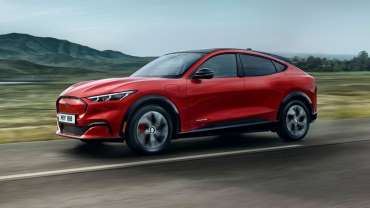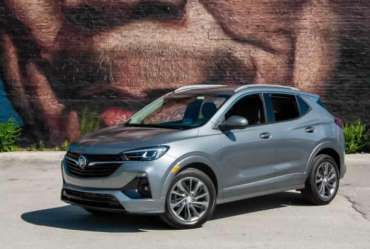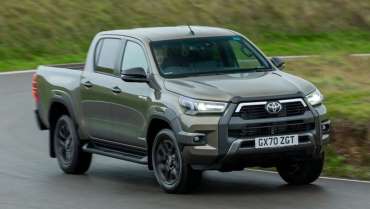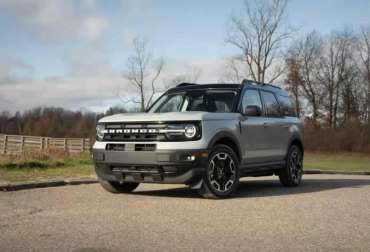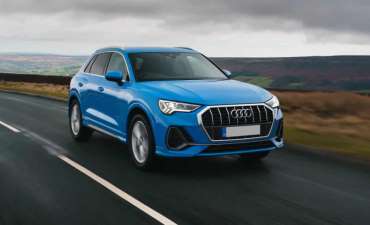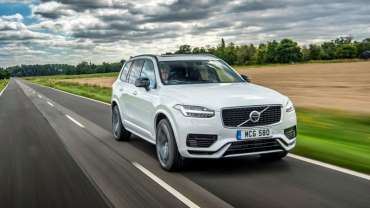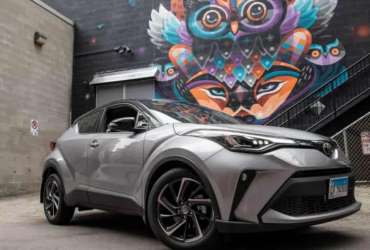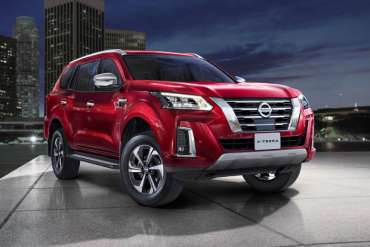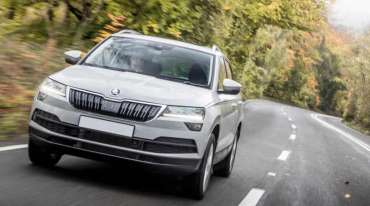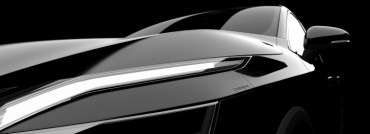Displaying items by tag: SUV
Ford Mustang Mach-E (2020) review: a new breed
Ford’s latest pony car is a near-silent, totally environment-friendly galloper shaped like a crossbreed cocktail of Aintree winner and steeplechase champion. Badged Mustang like millions of great American sports cars launched since the nameplate first popped up in 1964, the Mach-E is heralded as decidedly dynamic EV which puts street cred above cabin acreage and presence before lollipop aerodynamics.
Best electric SUVs
Similar to the reborn Bronco, the e-CUV is designated to build a bridge between the brand’s glory years and a planet-friendlier tomorrow. Question is, where exactly does the electric Ford rank in the fast growing catch-up queue which includes new arrivals like the VW ID.4 and the Volvo XC40 Recharge?
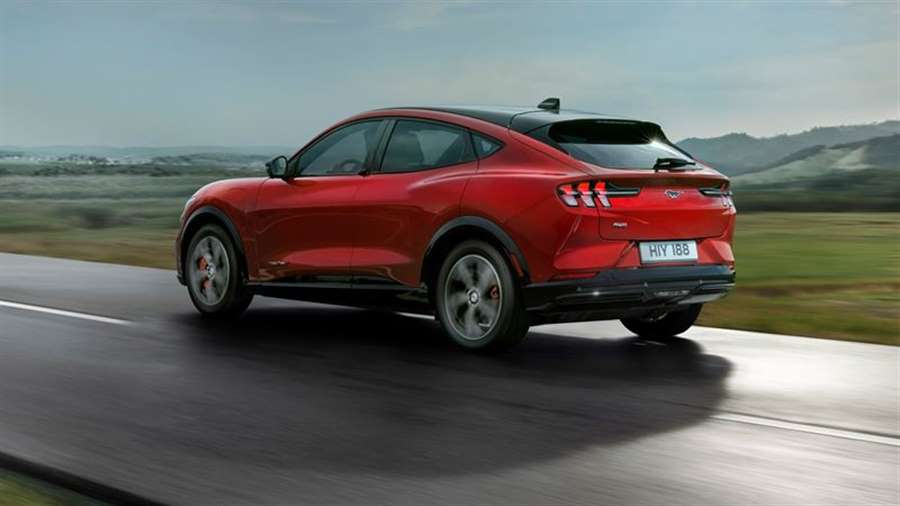
Give me a spec debrief
Designed in Dearborn, the Mach-E is arguably not quite centrefold pretty but well proportioned, functional and unmistakably Ford; like a grown up Kuga with pursed painted lips and a nicely rounded rear end with Mustang-style taillights.
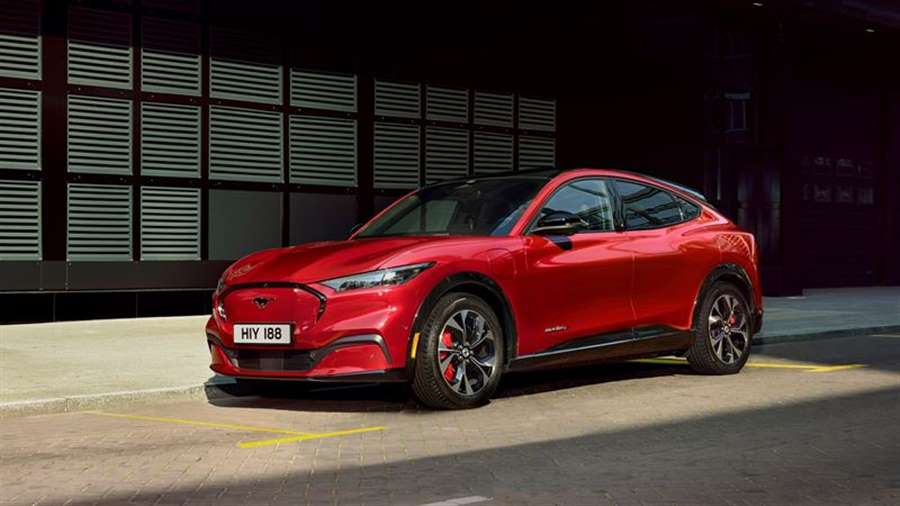
The cosseting cabin of the electric Ford is a notably more up-market suite on wheels than the loveless driver environment of the Tesla clad in plastified hide and jinxed with below-par build quality, the cheapo somewhat off-the-mark interior of the ID.4, or the iPace work station which appears to be different mainly for the sake of nonconformism. There’s a larger-than-life centre touchscreen running Ford’s new Sync 4 infotainment, complemented by a smaller rectangular display in the driver’s direct field of vision. With the exception of the rotary volume control, the buttons on the steering-wheel and the circular gear-selector first copyrighted by Jaguar, access to all MMI areas is by touchscreen and voice control.
Ford’s Sync 4 infotainment: does it work?
All first edition models (like our test car) of the Mach-E are already sold out, so your choice in the UK comprises Standard or Extended Range versions, both available with either rear- or all-wheel drive. Prices start at just over £40k before the plug-in car grant has been applied.
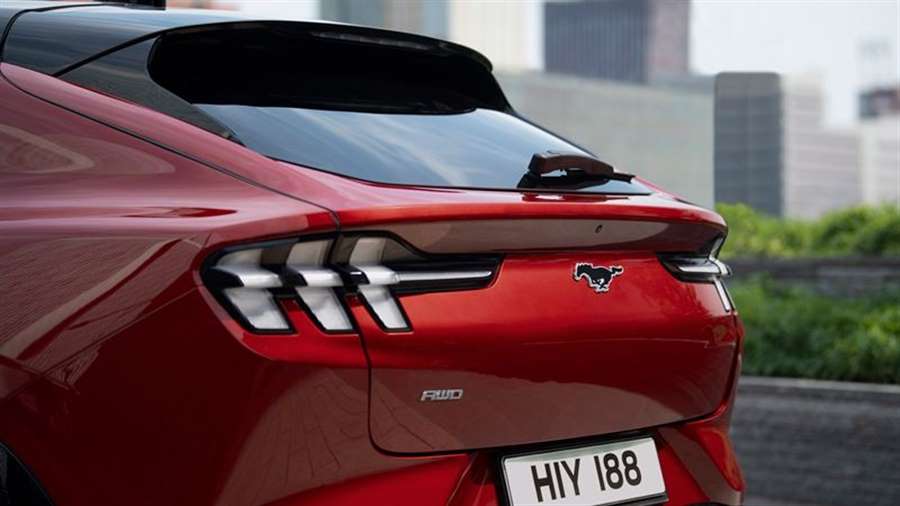
Here are the different versions:
Standard Range RWD: 265bhp, 6.1sec 0-62mph, claimed 273-mile range
Standard Range AWD 265bhp, 6.2sec 0-62mph, claimed 379-mile range
Extended Range RWD 290bhp, 5.6sec 0-62mph, claimed 248-mile range
Extended Range AWD: 346bhp, 5.1sec 0-62mph, claimed 335-mile range
Ford is also planning a Performance Edition, though that’s as-yet unconfirmed for the UK. For comparison, the most potent Mach-E is around four grand more expensive than the 340bhp Model Y AWD, which fields a less potent 72.5kWh battery but will accelerate in 5.1sec from 0-62mph, reach a top speed of 135mph and can charge with up to 250kW. While the blue oval effort is restricted to 111mph, it matches its key rival against the stopwatch, and it boasts 21 miles of extra distance.
Let’s drive!
Oddly, the first few miles disappoint. What’s wrong with this chewing-gum steering which feels as if a rope with a sack of potatoes attached to both ends was straddling the rack? Switching off the lane guidance fixes it: no more woolly self-centering now, no half-hearted auto-corrections, no vague feedback with increasing lock. The insurance companies love these assistance systems, committed drivers hate them.
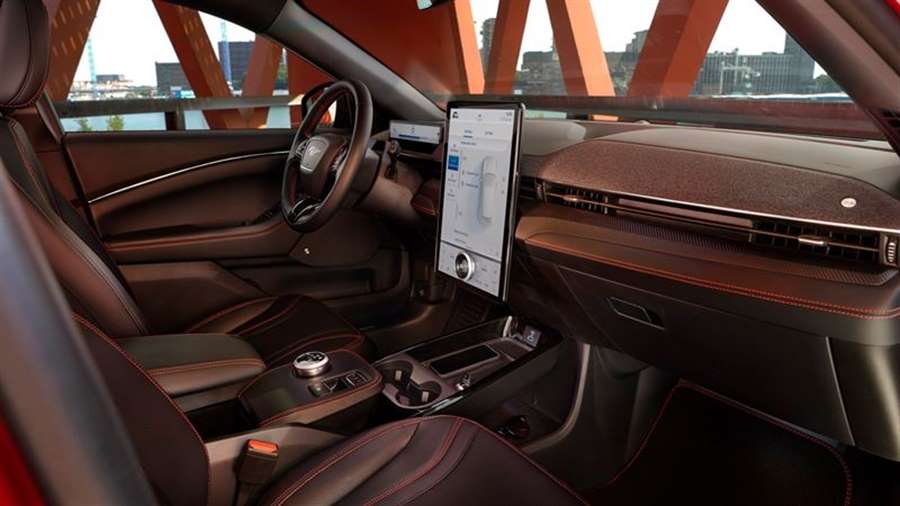
After many hours behind the wheel, the steering no longer feels quite so odd, though that V-shaped self-centering phenomenon and the on-lock lightness have not gone away completely. Instead, assets like the pinpoint accuracy, the relatively tight turning circle of 11.6 metres and the balanced damping have come to the forefront.
The low-speed ride is knobbly, but that weighty skateboard underneath gets into a rhythm above 40mph. Composure remains flat at all times (thanks to the low centre of gravity and a pair of anti-roll bars), and the straight-line stability is as unperturbed as the car’s stance through hurried changes of direction, under hard braking and when staging a borderline overtaking act which is obviously never ever interrupted by a potentially critical upshift action.
How fast is it?
Well, to make the best use of the Mach-E is to play with the new drive modes, poetically named Whisper, Active and Untamed. In Whisper, the steering is too light and there is a Do Not Disturb sign dangling from the accelerator pedal. In contrast, Untamed cannot wait to unlock the high voltage corral and speed up the direction determinator, but the computer-generated driving noise sounds like the tumble dry programme of a distant washing machine, lift-off exaggerates that controversial one-pedal feel, and fake downshifts are the rule under braking. No, thanks. So, Active it is, which strikes a purposeful balance between relaxed and excited, makes coasting a way of life, subtly synchronizes the sensations telegraphed to your palms and feet. Sadly, there are no shift paddles to play with, be it to trigger instant energy regeneration or release momentum for a more emphatic flow.
Still in Active, the brakes are every bit as attentive as the throttle, the stopping power is strong and progressive, and despite repeated attempts we could not detect the exact transition point between electric and hydraulic deceleration. If anything, this time-warp energy-squashing system needs a strong right foot to combat the slowly rising pedal pressure.
Ford Mustang Mach-E: verdict
Ford’s first fully electric planet-saver is fun to drive, commendably efficient as well as cool to look at and to be seen in. The brittle low-speed ride and synthetic steering mark it down, but there’s a little more flair here than a Tesla Model Y.
Source: carmagazine.co.uk
2020 Buick Encore GX Review: Premium Pablum
The verdict: The new 2020 Buick Encore GX is a small, premium-priced SUV that feels neither premium nor exciting, with bland materials and a meek powertrain. It gets the job done, though — assuming “the job” is mostly “being a little bigger than an Encore” (which remains in Buick’s lineup).
Versus the competition: Buick’s entry in the seemingly never-ending stream of small SUVs is outshined by others in the class that offer nicer interiors or far better driving experiences — or sometimes both — for thousands of dollars less.
The Encore GX is Buick’s latest and second-smallest SUV, bigger only than the Encore, which was one of the first subcompact SUVs on the market and the brand’s bestseller. The Encore is smaller than both the Envision and Enclave and offers buyers a choice of front- or all-wheel drive and two turbocharged three-cylinder engines. The Encore GX with FWD has a continuously variable automatic transmission, while AWD versions get a more traditional nine-speed automatic. Trim levels, in ascending order, are Preferred, Select and Essence.
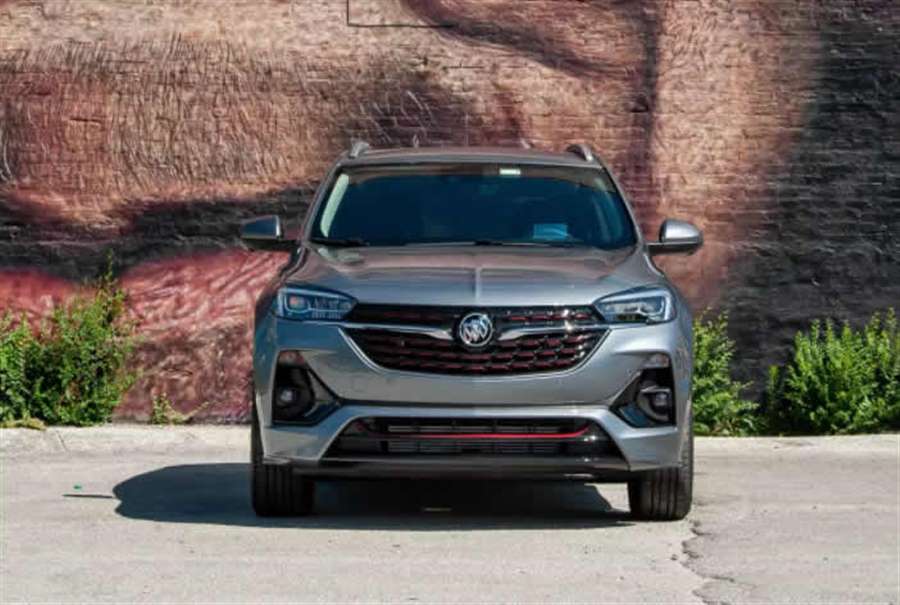
My test vehicle was a FWD Encore GX in the top Essence trim. It had the optional turbo 1.3-liter engine and Buick’s Sport Touring, Convenience and Advanced Technology packages. The Sport Touring package ($650) adds a dash of spice, with body-colored side molding, “sport” front and rear bumpers, a unique grille with red accents and package-specific 18-inch wheels (different from the 18s every Encore GX gets standard). The advanced technology in the Advanced Technology Package ($1,790) includes a 360-degree camera system, a head-up display and built-in navigation. The Convenience Package ($770) adds automatic parking assist, a rearview camera mirror and rain-sensing windshield wipers. Our test vehicle’s total price, including a $995 destination fee, was $34,115.
That’s a fair amount of money for a small SUV that, at its best, evoked feelings of “This car sure is … adequate.” The Encore GX competes against other small SUVs like the Mazda CX-30, our recent SUV-comparison-test-winning Kia Seltos, and a vehicle with which it shares its platform, the Chevrolet Trailblazer.
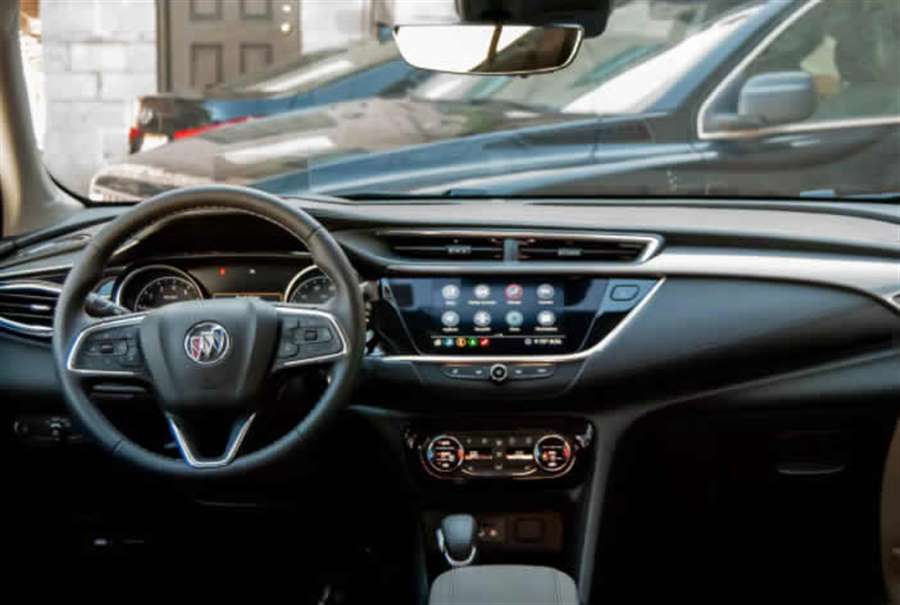
Even with its more powerful optional engine, the Encore GX still has only 155 horsepower, which isn’t many ponies to call upon when the accelerator is pressed. It’s never going to be a quick car, but that’s almost certainly fine for those considering buying one. It’s quiet on the highway and remains fairly composed at higher speeds despite its small size. Passing maneuvers are a bit of a stretch, but once the Encore GX wakes up from its highway hypnosis, it does what you want.
Around town, particularly in the model I drove, with front-wheel drive and a continuously variable transmission, you really need to stand on the gas to keep up with aggressive city traffic. This caused one of my least favorite behaviors in the GX: torque steer. There was so much torque steer — a phenomenon in which engine power applied to the front wheels causes them to pull to one side or the other. The wheel would practically jump out of my hands trying to turn to one side under strong acceleration, which would be more forgivable if the Encore GX were impressively quick or at all fun to drive. As it is, it’s just aggravating; I’d recommend choosing an AWD model for this reason alone. There also aren’t any available driving modes to increase throttle or transmission response or to tighten up the suspension or steering.
Steering itself feels numb and vague; it doesn’t communicate where the nose and wheels are pointed at any given moment. There’s so much play in the steering wheel before it actually turns the wheels, it reminded me of an early-2000s Mercury Grand Marquis — or the time I was 12 and got to steer a DUKW during a Boston Duck Tour in the Charles River.
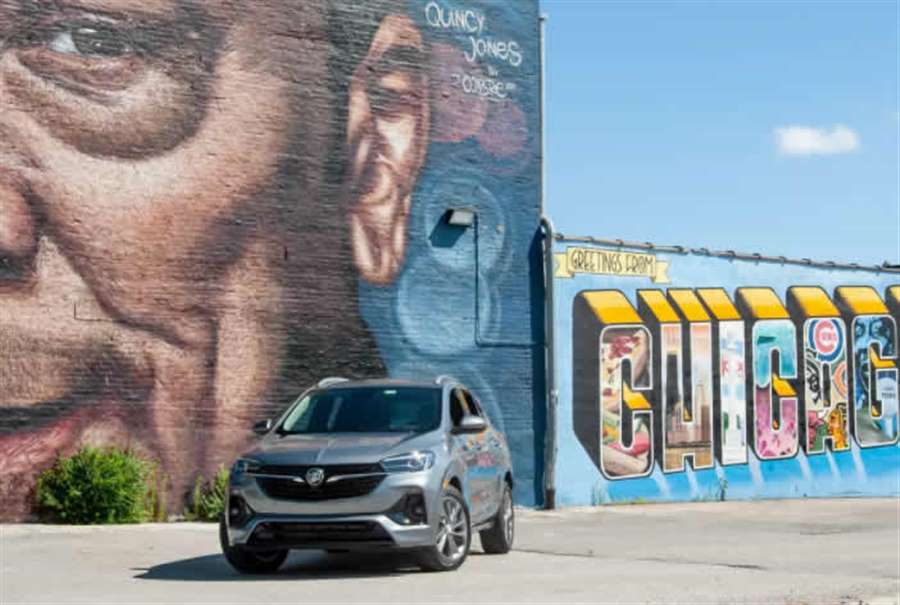
Choppy pavement — of which there’s plenty around Chicago — unsettles the Encore GX more than other small SUVs I’ve driven over the same roads. There was also more body roll in turns than I expected. The SUV feels like a much bigger vehicle when you’re driving it until a modern RAV4 pulls up alongside and dwarfs you, which may appeal to buyers looking for a big car feel without an actual big car.
Or big-car fuel economy, for that matter. Our FWD-and-turbo 1.3-liter engine combo is the most efficient of the Encore GX range, with EPA-estimated gas mileage of 30/32/31 mpg city/highway/combined. With AWD, those ratings dip to 26/29/28 mpg. The FWD turbo 1.2-liter GX is rated 26/30/28 mpg. The Mazda CX-30’s much more engaging driving experience is also less fuel-efficient; FWD versions top out at 25/33/28 mpg and AWD SUVs at 25/32/27 mpg.
One much-appreciated feature on the Encore GX was the ability to deactivate the engine’s automatic stop-start feature. GM had not previously allowed owners to turn the feature off, and while reducing engine idling is good for the environment, being stuck in a traffic jam on a sweltering summer day with an engine that refuses to run while stopped — significantly reducing the air conditioning’s effectiveness — has made me yearn for at least the option to deactivate. It seems GM finally trusts its owners in this regard.
Despite the Encore GX’s high price, its interior doesn’t have a premium or even fun feel. The monotone interior you see above has the materials quality you’d expect in an SUV priced a few thousand dollars less. Truly, the only premium or near-premium interior in this class belongs to the Mazda CX-30, but at least other contenders in the segment don’t position themselves as upmarket choices the way Buick does.
That said, the Encore GX’s features do have more of a premium feel. It has an available head-up display, rearview camera mirror, 360-degree camera system and available self-parking feature. But those features aren’t tangible and aren’t always in use, whereas Encore GX drivers are always sitting on low-quality leather (in the Essence) or touching parts of the interior that could use more padding. Even the head-up display is an old-school flip-up version that sounded like a cassette tape being ejected whenever it rose into position or folded down when the car was turned off. The HUD is at least visible when wearing polarized sunglasses, so kudos to Buick for that.
Buick’s standard 8-inch touchscreen infotainment system is adequate, with standard Apple CarPlay and Android Auto (2021 models also get standard wireless compatibility). It has modern enough graphics and a straightforward user interface. For all the ways the CX-30 tops the Buick in premium feel, Buick has Mazda beaten here.
Visibility is fine, with no major blind spots, and the optional 360-degree camera system helps out in tight spots. I was comfortable in the backseat, with decent headroom and legroom. Buick estimates cargo volume at 23.5 cubic feet with the backseat upright and 50.2 cubic feet with it folded down. The smaller Encore has 18.8 and 48.4 cubic feet, respectively. A trip with four adults — or even two parents and two kids — might be pushing it, but two adults plus pets will be fine. Based on manufacturer specifications, the CX-30 has less cargo volume, while the Seltos and Trailblazer have more.
Standard safety features on the Encore GX include forward collision warning with automatic emergency braking and pedestrian detection, lane departure warning, lane keep assist and automatic high beams. That’s a big deal for a GM product; traditionally, some or all of these features have been higher-cost options. Some features are still optional, including adaptive cruise control, blind spot warning with rear cross-traffic alert, a 360-degree camera system, a head-up display, a rearview camera mirror and an automatic parking feature.
The 360-degree camera system was very useful and I’ve already praised the head-up display’s visibility with polarized sunglasses, but the Buick’s other features felt more nice-to-have than necessary. I’ve never been a huge fan of rearview-mirror camera displays, as they always disorient me a little by providing a slightly different view than what my eyes expect. And automatic parking assist would be more useful if the Encore GX weren’t already so small and easy to park. I’ve used similar features on larger vehicles to help determine if an unfamiliar car would fit in a particular spot, but the answer to that question in the Encore GX is almost always “yes.”
The Insurance Institute for Highway Safety hasn’t yet crash-tested the Encore GX. In this regard, it should not be mistaken for the other Encore, which has an entirely different platform and, thus, different crash characteristics. Once the Encore GX is tested, the results will appear here, with other small SUVs. The National Highway Traffic Safety Administration gave the Encore GX a four-star overall safety rating, out of a possible five stars. In our Car Seat Check of the Encore GX, the small SUV earned mixed scores
Is the Encore GX a Smart Buy?
It’s hard to say if the Encore GX is a smart buy. On the one hand, with sticker prices at the top of the line approaching — or even exceeding — $35,000, the model is hard to recommend. But will buyers ever need to pay even close to sticker price?
I prefer the Chevrolet Trailblazer to the Encore GX both in terms of interior quality and driving experience, and the Mazda CX-30 far surpasses the Encore GX in everything but infotainment systems. If, however, you care about buying a car from a domestic brand that’s ostensibly nicer than Chevrolet — even if the car itself is assembled in South Korea — and if you can get a decent deal on an Encore GX, it will likely meet your needs.
Source: cars.com
New Toyota Hilux 2020 review
The Toyota Hilux pick-up has been updated for 2021, and now boasts a punchy 2.8-litre diesel engine
Verdict
The Toyota Hilux has always been seen as a practical, no-nonsense work vehicle, and the latest updates mean it should be on any premium pick-up truck buyer's shortlist. The new engine packs a punch without impacting running costs too severely, while the Invincible X model has the looks and kit to appeal to buyers that need an upmarket work vehicle that also can carry a family in comfort - all while offering more off-road ability than most buyers could possibly need.
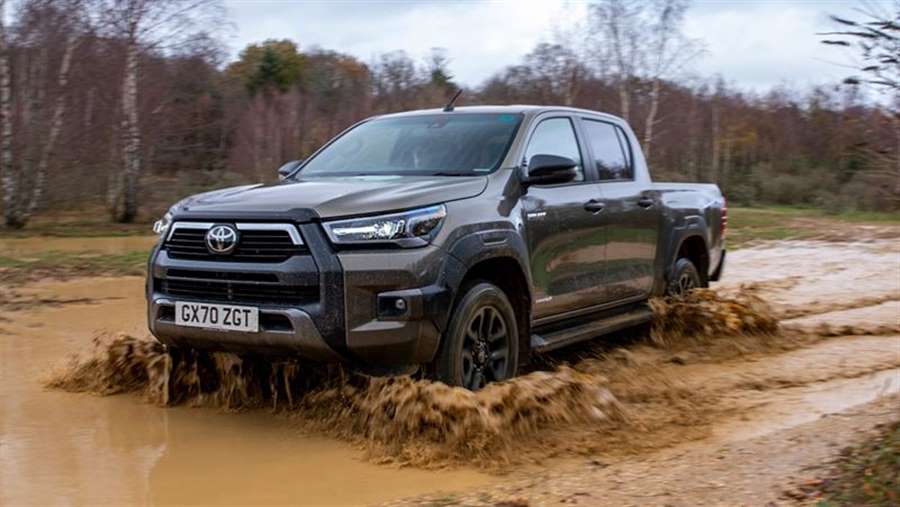
Of all the pick-up trucks for sale in the UK, the Toyota Hilux is the one with a reputation that precedes it. It's become a beacon for Toyota's reputation for reliability and durability, and is found in all four corners of the globe. However, when it comes to the 'lifestyle' angle of the UK's one-tonne pick-up class, it has never quite hit the mark.
One thing that's held the Hilux back is a relative lack of power. Unlike rivals, Toyota has never offered the Hilux in the UK with a high-power engine, but that's all change for the 2021 model year, with the arrival of a new 2.8-litre diesel packing 201bhp. That means the Hilux is now second only to the Ford Ranger in the four-cylinder pick-up pack for power. It's available with six-speed manual or auto gearboxes, while selectable four-wheel drive and low-range gears make the most of that power and the 500Nm of torque on offer. An automatic limited-slip diff in 2WD mode also helps with traction when running in the Hilux's most efficient setting.
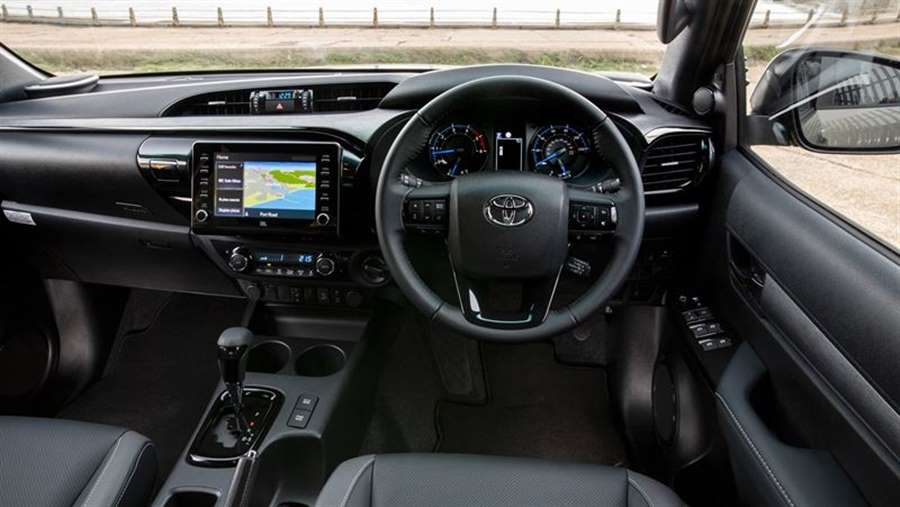
Other revisions under the skin include suspension that has been tuned to deliver a smoother ride when unladen, helping to reduce the amount of bounce that one-tonne pick-ups often suffer from when there's no payload in the back. Also, the power steering now offers variable assistance depending on which drive mode is selected, with extra assistance given in low-range mode for off-road driving.
On the road, the Hilux has definitely been improved. The engine can still get noisy under acceleration – especially if you use the whole rev range – but the extra power means you don't spend as much time on the throttle as before. That automatic LSD function helps get the power to the road in 2WD mode with minimal fuss, too. When you do back off, the cabin is quiet and refined, with next to no wind or tyre noise. It's a real step change for the Hilux, and means this truck now offers the kind of hushed cruising that you'd get from an SUV.
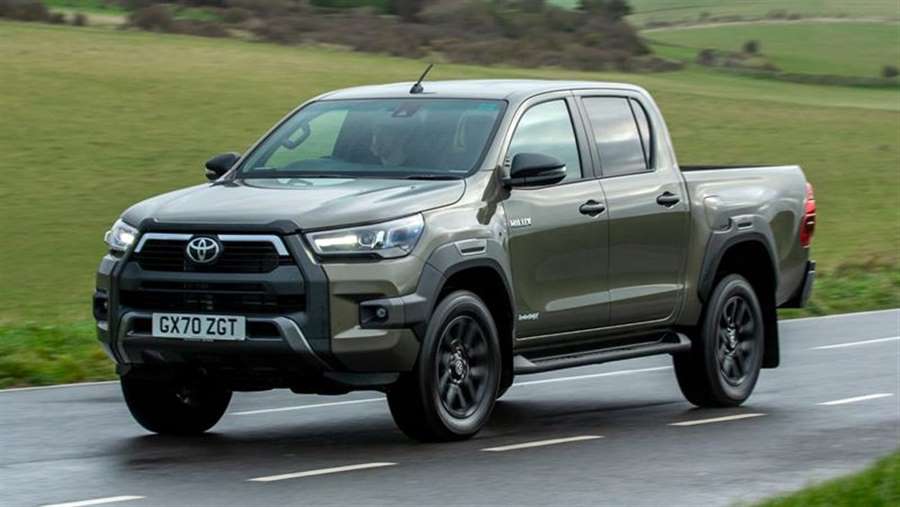
However, while the revised suspension is designed to help eliminate 'bounce', the Hilux isn't automatically a smoother ride than a Ford Ranger. There's a distinct patter sensation when running over bumps, with the front and rear wheels delivering a similar amount of movement back to the cab. In comparison, a Ranger's front suspension will smooth out a bump, but with the rear having a bit more of a jolt to it. Overall it means that the Ranger feels like it offers a better compromise than the Hilux when unladen. Still, the Toyota is a better performer than the Mitsubishi L200, while the leaf spring set-up is more composed than the multilink system found on the Nissan Navara.
What really impresses is that Toyota has managed to improve the Hilux on tarmac without compromising its off-road talents. Even on standard road-biased tyres, the Hilux offers a level of ability in the rough that will meet the demands of almost all drivers. Simply switch to the low-range 4WD setting, and a suite of electronic aids will help you battle through the rough stuff. Hill descent control, a reprogrammed stability control system, improved throttle response and a lower engine idle speed mean the Hilux is better suited to off-road driving than ever.
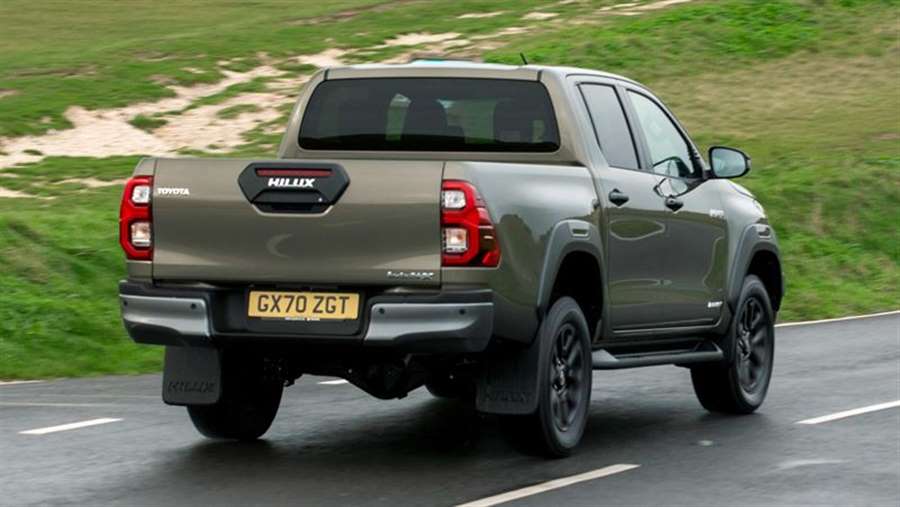
Go for the top-spec Invincible X model, and the 201bhp diesel is standard (the 2.8 is optional in Invincible trim, while lower-spec models come with the existing 148bhp 2.4-litre diesel), and there's a long list of extras, too. The X gets a unique exterior look, with minimal chrome trim, black cladding for the grille, wheelarches and tailgate, plus exclusive 18-inch wheels and black chrome housings for the standard LED headlights.
Inside, a JBL audio system delivers excellent sound clarity - although the dashtop speakers do reflect slightly in the windscreen - and sat-nav is included with the infotainment, although the new eight-inch touchscreen also introduces Apple CarPlay and Android Auto to the Hilux if that's your preference. There are heated leather seats up front, ambient lighting throughout the cabin and everything feels well built. Maybe it's not quite as plush as an SUV, but you certainly don't feel short-changed.
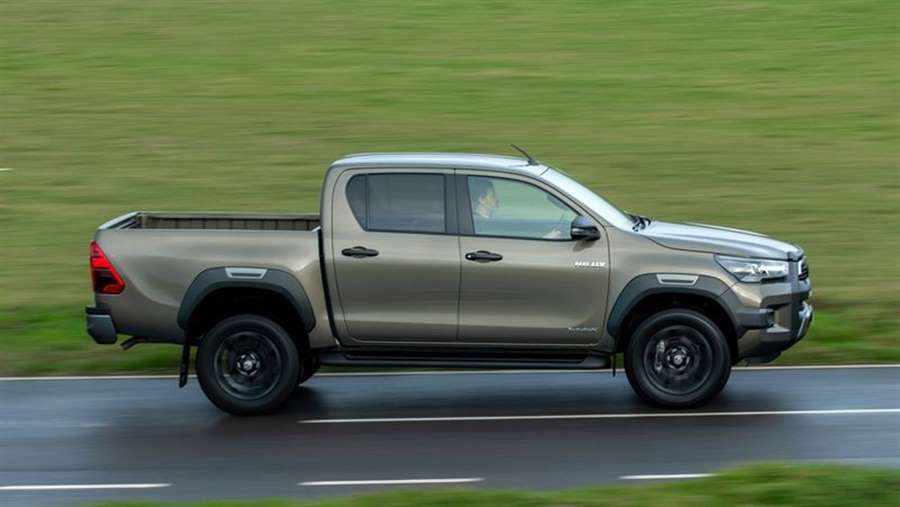
Competitive finance rates help with that, too. Thanks to strong residuals, the Hilux is available with competitive finance rates. Add in Toyota's five year/100,000-mile warranty if something unexpected happens, and this is a pick-up that makes a strong case for itself.
SOurce: autoexpress.co.uk
2021 Ford Bronco Sport Review: Who Ordered the Budget Land Rover?
The verdict: This Ford’s combination of on-road manners, genuine off-road ability, slick interior designs and rugged good looks make it a Land Rover for budget-minded buyers.
Versus the competition: The only compact SUV that comes close to what the Bronco Sport can do is the “trail-rated” Jeep Cherokee Trailhawk, and even then, the Bronco costs less. Other compact SUVs might have more interior room, but they’re really meant only for on-road driving, not cross-country adventures like the Bronco Sport.
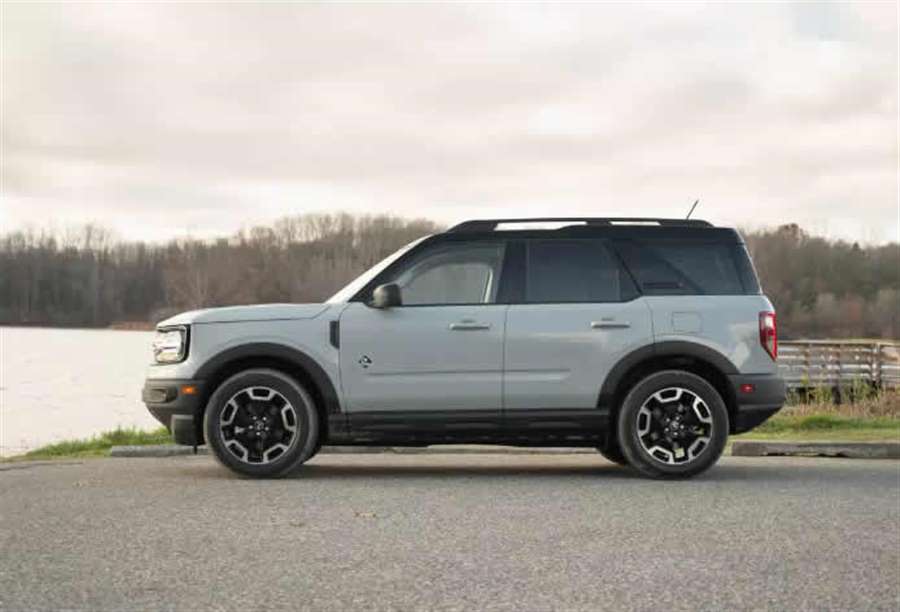
Yes, I know, we’re all very excited for the arrival of the 2021 Ford Bronco, and everyone’s just abuzz about it: How well does it go off-road? Is it better than a Wrangler? Is the top easy to take down? How heavy are the removable doors? And so on. But what we should keep in mind is that Ford introduced not one but two SUVs under the Bronco name: the “big” Bronco and this one, the 2021 Ford Bronco Sport.
Here’s where the off-road purists start their lament: “Oh, that’s not a proper off-road vehicle,” they’ll say. “That’s just a Ford Escape with some off-road bits stapled to it.” And while that’s not entirely inaccurate, it’s also not the whole story. Ford has made a lot of hay about how the big Bronco is super-capable off-road, with tons of technology, best-in-class specs and some genuine trail cred. Then the company pasted that “Bronco” name onto the front of this smaller, compact SUV — and that should also tell you something about it.
The compact Bronco Sport does indeed share some of its hidden bits with the Escape (as well as the no-longer-sold-in-the-U.S. Focus sedan), but those are common structural parts no buyer will ever see, like the expensive-to-make firewall stamping and other underbody elements. The Bronco Sport is shorter than the Escape both in wheelbase and in overall length, sporting very different dimensions aimed at creating a highly capable off-road SUV meant to challenge the Jeep Cherokee. Along the way, Ford has thoroughly engineered the SUV to do things that will surprise a lot of off-road purists who think only a body-on-frame, super-lifted, rear-wheel-drive, truck-based monster can successfully conquer trails. After spending an afternoon in the Bronco Sport with free run over a challenging off-road park, I’m here to tell you it may be a better choice for an everyday off-roader than the big Bronco itself.
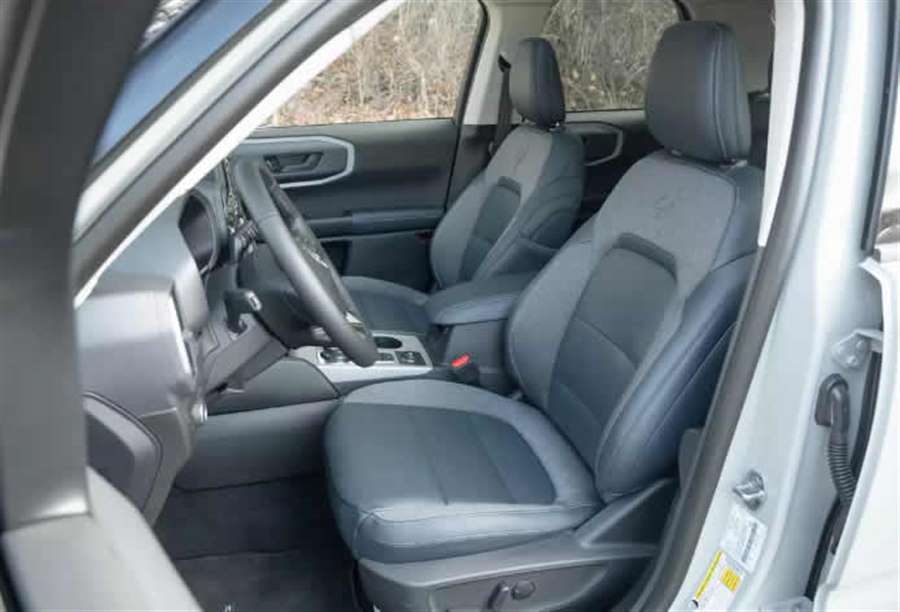
Let’s start with a quick discussion of the various types of Bronco Sport you can buy, as Ford has created five trim levels, each providing a different kind of experience. In order of increasing content, they are Base, Big Bend, Outer Banks, Badlands and First Edition.
The Base trim is exactly that: a no-frills compact SUV featuring everything you need for adventure, including a peppy turbocharged 1.5-liter three-cylinder engine cranking out 181 horsepower and 190 pounds-feet of torque. It’s mated to a standard eight-speed automatic transmission that sends power to all four wheels. It has all the basics, like an 8-inch display screen, 17-inch wheels, an electronic Terrain Management System with Ford’s “G.O.A.T. Modes” (stands for “Goes Over Any Type of Terrain”), Ford Co-Pilot360 safety systems and more. Choose the Big Bend model and you’ll get some additional content, including two-way manually folding rear seats, privacy glass, push-button start, rubberized cargo floors and some other nice-to-have bits and pieces. The Outer Banks model is meant to be the nicer “luxury” version, with a leather interior, power seats, a digital gauge cluster and bigger 18-inch wheels. In “Jeep-speak,” you’d call this one the Sahara trim.
Then we get to the top off-road model, the Badlands. It swaps out the turbo 1.5-liter engine for a 2.0-liter one that makes 250 hp and 277 pounds-feet of torque. It gets a 1-inch lift kit, a special off-road suspension, off-road tires, a more advanced four-wheel-drive system with a twin-clutch rear-drive differential, seven G.O.A.T. modes instead of five, underbody bash plates, tow hooks, a front trail camera and more. There’s also an even more exclusive First Edition model, but it’s already sold out, so I won’t bother with that one. Instead, let’s focus a lot of our attention on the Badlands model — which is deserving of that attention because it’s extraordinarily impressive.
Out On the Road
The first thing you’ll notice about the Bronco Sport if you drive any version of it is that it feels like a bigger SUV than it is. The hood feels almost horizontal, and it’s big, square and very traditional-feeling, creating a similar sensation to sitting in the bigger Bronco. It’s pleasingly boxy, helping you see the corners of the SUV — useful in off-road situations or parking lot maneuvers. That formidable hood is the only thing that feels big about the Bronco Sport, though, as the rest of its dynamics show it to be a nimble, tight-handling little SUV that’s as good to drive on the street as it is in the dirt.
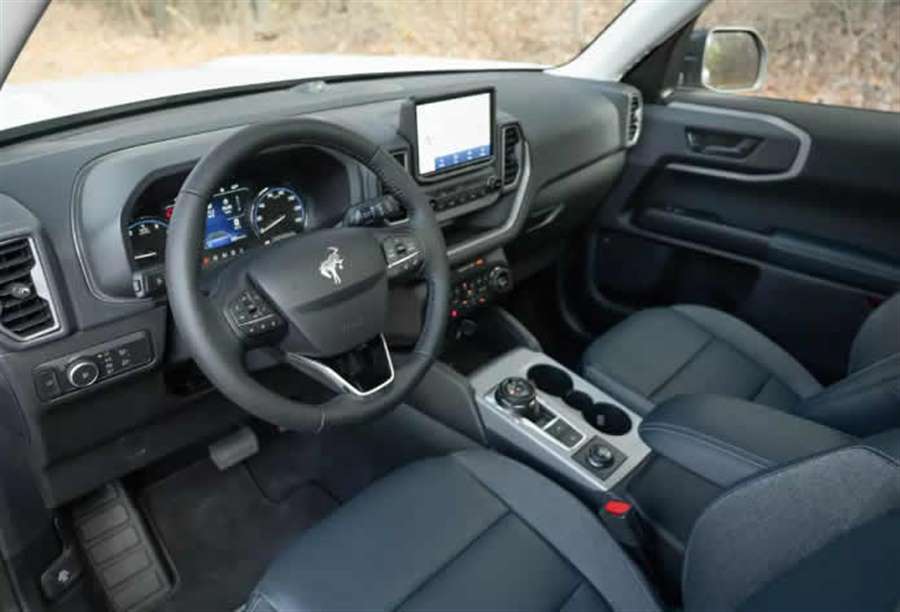
The turbocharged 1.5-liter engine that comes in the vast majority of Bronco Sports is torquey, peppy and has plenty of grunt for around-town driving. Slip the G.O.A.T. mode selector into Sport and it becomes truly quick, with the eight-speed automatic transmission keeping things on boil by maintaining a lower gear than it would in the normal driving mode. It does tend to run out of steam at higher speeds, however, so passing maneuvers on highways might require a little planning, but it never feels slow or ponderous in its operation; for the vast majority of users, it’s going to be plenty of motor. The optional turbo 2.0-liter engine takes things to the next level: Available only in the top Badlands and sold-out First Edition trim levels, you’ll pay for the privilege of extra power, but it does show noticeably better performance on acceleration. Honestly, though, I’d be perfectly happy with the 1.5-liter engine; the 2.0-liter seems more like a perk than a benefit.
The Bronco Sport handles well, too — despite fairly highly boosted steering feel — and definitely features some different characteristics depending on which trim level you choose. Lesser trim levels with their all-terrain tires feel a bit tighter, while the Badlands and its softer, lifted suspension and dedicated off-road tires feels a bit floatier. The Badlands is also a bit louder since its knobbier tires send more road noise into the cabin; given the Bronco Sport’s off-road intentions, though, this is neither unexpected nor unwelcome. The overall on-road driving experience is impressive, combining carlike handling with easy operation, a tall driving position, excellent outward visibility and the traditional crossover characteristics that have made the body style so popular.
Deep in the Woods
The purpose of a Bronco Sport is not commuting; for that, Ford has the perfectly capable Escape. The Bronco Sport’s on-road civility means you can commute in it just fine, but it has the equipment, technology and engineering to be a highly capable off-road machine. Ford likes to bill the Bronco Sport as having a different mission than the big Bronco. The Sport is for getting you to basecamp with all your stuff so you can do whatever you came to do, whether hiking or kayaking or mountain biking. The big Bronco is meant to go further — to be the very reason you’re out in the wilderness, the activity you went off-road for. If that’s the case, though, Ford has made the Bronco Sport far more capable than it needs to be.
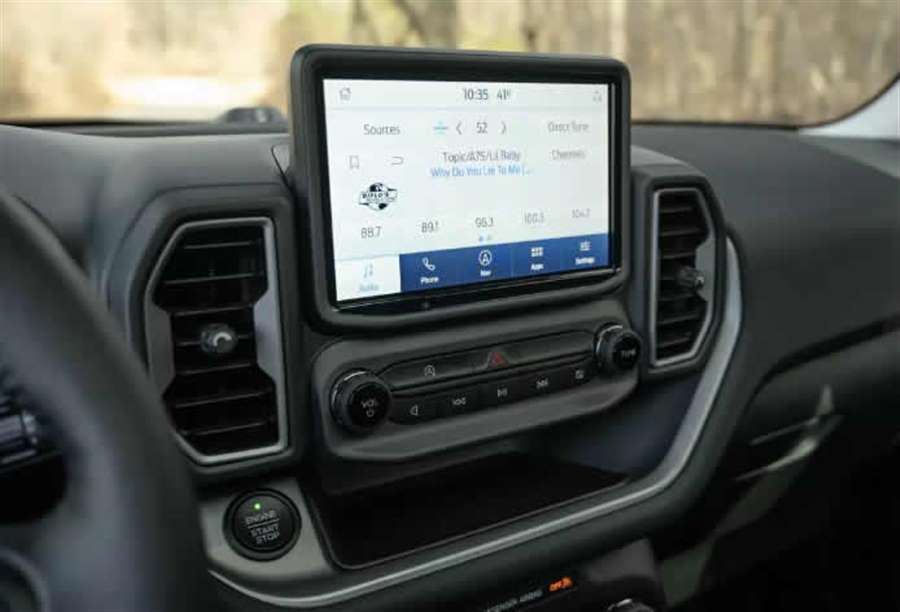
My afternoon with a Bronco Sport at the Holly Oaks Off-Road Vehicle Park in Southeast Michigan saw me take a Badlands over slippery rock faces, through high-speed sand pits, around tight wooded trails and down steep declines, all meant to be challenging for any SUV — and likely impossible for the vast majority of cute-ute crossovers. The Bronco Sport not only handled such obstacles with ease, it did so with a level of comfort that was absent in my previous ride-along in a big Bronco. Given its smaller dimensions that make it easier to shepherd through tight trails, one wonders if the Bronco Sport isn’t the better choice for a “casual” off-road adventurer, leaving the more expensive, heavier big Bronco for those who want the most hardcore experience they could have.
Ford makes it easy to take the Bronco Sport into the muck thanks to the use of its G.O.A.T. modes. The Badlands has seven of them, adding Mud/Ruts and Rock Crawl to the standard five of Normal, Eco, Sport, Slippery and Sand. You can lock the four-wheel drive yourself, but switching into the mode that matches your environment will do that for you as needed, along with making adjustments to things like electronic steering feedback, throttle input, transmission shift points, traction control and more.
This is where the budget Land Rover comparisons come in. The system feels similar to how the latest British-brand luxury SUVs handle a lot of their off-road duties. The Bronco Sport will match a lot of the abilities of a vehicle like a Land Rover Discovery Sport, and it comes with the added perk of a slew of more than 100 factory-approved accessories, ranging from lights to racks to rooftop tents that can be ordered along with the SUV at the point of purchase. Using their Terrain Response system, Land Rovers adjust a lot of the same systems Ford does with its G.O.A.T. modes, allowing for a multiple-personality SUV that’s perfectly comfortable on-road and perfectly capable off-road. Simply drive off the pavement, switch into the mode that best describes what you’re about to drive over, and away you go — no fuss, no muss. It works exceptionally well and will allow a lot of less experienced off-roaders to do things that require a bit of training in, say, a Jeep Wrangler, in which you need to know how to adjust most systems and equipment yourself. To Jeep’s credit, the Cherokee has a similar system that also adjusts various vehicle systems to the conditions; a full-on matchup between the Bronco Sport and Jeep Cherokee is an absolute must, and soon.
Getting There Is Half the Fun (Possibly Three-Quarters of It)
In addition to crafting a massively capable budget Land Rover out of a Ford Escape, the Blue Oval has also added a considerable dash of style and utility to the interior. The Bronco Sport’s interior is completely different from the Escape’s, with a more industrial, rugged look to the shapes and surfaces that’s entirely in keeping with its family lineage to the Bronco line. There’s even an available rubberized floor covering in case you want something that’s easy to wipe out. It’s also notable that Ford has introduced to the Bronco Sport interior color that’s missing from a lot of SUVs these days — shades of blue, bronze, silver and orange that are all a welcome departure from the dull greige in a lot of competitor vehicles.
While the interior is good, it’s also not perfect. As is the case with a lot of Fords, the seats feel smaller than they should be and are shaped in uncomfortable ways. The Badlands model’s optional leather-covered chairs had bottom cushions with an odd dome that made me feel like I was sitting on an exercise ball. The backseat is not terribly generous in the legroom department — likely a function of losing some wheelbase versus the Escape. Headroom isn’t an issue thanks to the Bronco Sport’s safari-style roof and upright, boxy styling. The cargo area looks plentiful, but Ford has not yet published dimensions for the Bronco Sport, so comparisons with other compact SUVs are difficult at this time. Of note here is the standard flip-up glass rear window, which is a feature you don’t often see anymore but which is useful for just popping something into the cargo area without having to open the entire hatch (and maybe having things spill out).
On the technology front, the Bronco Sport has all the modern amenities and safety conveniences you might expect from a new Ford, plus maybe one or two tech bits that seem a little odd. First, Ford Co-Pilot360 is standard, bringing things like automatic emergency braking with pedestrian detection, forward collision warning, blind spot warning, rear cross-traffic alert, lane keep assist, auto high beams and a backup camera. Upgrade to Co-Pilot360 Plus and you’ll also get adaptive cruise control with lane-centering, evasive steering assist and more.
The multimedia system in the Bronco Sport is curiously not the latest Sync 4 system you can get in the new 2021 Ford F-150, but rather the older Sync 3 system that runs on an 8-inch touchscreen. It’s a little small in terms of display size — most new competitors have larger screens — but it’s as large and up-to-date as the system in the Escape. It also has something that Sync 4 doesn’t have: a “home” button, which we never thought we’d miss until Ford eliminated it in the F-150. The system still works fine, syncing up with a smartphone without issue, and provides Apple CarPlay or Android Auto in case you don’t want to use the native Ford systems.
Source: cars.com
Audi Q3 Review
The Audi Q3 is an upmarket compact SUV that delivers owners loads of high-tech features and lots of cabin space. It’s not that enjoyable to drive, however
The Audi Q3 is a spacious and stylish family SUV with a great interior and lots of hi-tech features. It’s an alternative to the BMW X1 and Volvo XC40 and sits between the Q2 and Q5 in the enormous range of SUVs available in Audi’s line-up.
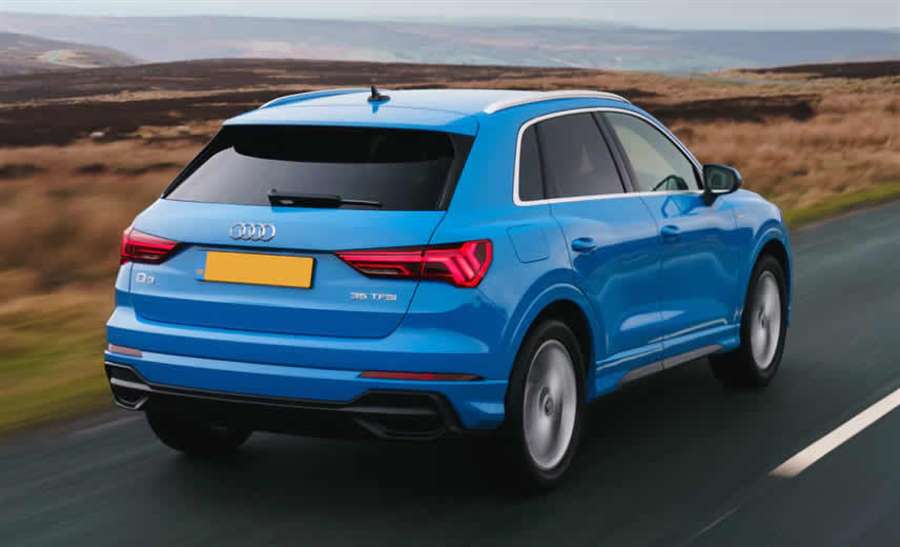
That line-up can be a bit like watching Eastenders and trying to decide which Mitchell brother is on the screen – they do look very similar. That’s good in some cases and bad in others, depending on the price they’re charging. The Q3 is, thankfully, in the sweet spot.
The Audi Q3’s grille looks like a smaller version of the Q8’s, for example, while the exterior design is similar to the Q5’s, but smaller. This kind of Russian-doll styling is common in a lot of car manufacturers, so we can’t hold too much of a grudge.
All Audi Q3s get a set of digital dials with sat-nav functionality and more, which is great to see – and the standard infotainment screen is sharp and easy to use. The Q3 scores highly for tech, as it feels like a more expensive model in that regard.
It’s a similar story when it comes to upholstery and interior materials, as the Q3 is well-built, looks smart and has some customisation options including an Alcantara trim that looks and feels great.
It has a typically high-up SUV driving position with plenty of adjustment, which means you can get comfortable quite easily. Plus there’s lots of room in the front seats and no headroom issues at all.
There’s no doubt the Audi Q3 has been inspired by the vast Q8 SUV – that giant grille, for example, makes it look just like a toddler that’s trying on its Grandparent’s dentures
Mat Watson, carwow expert
Plus, in the rear seats the Q3 has more room than you’ll find in many other cars of this size, and you can slide the rear seats forwards and backwards to prioritise either passenger legroom or boot space.
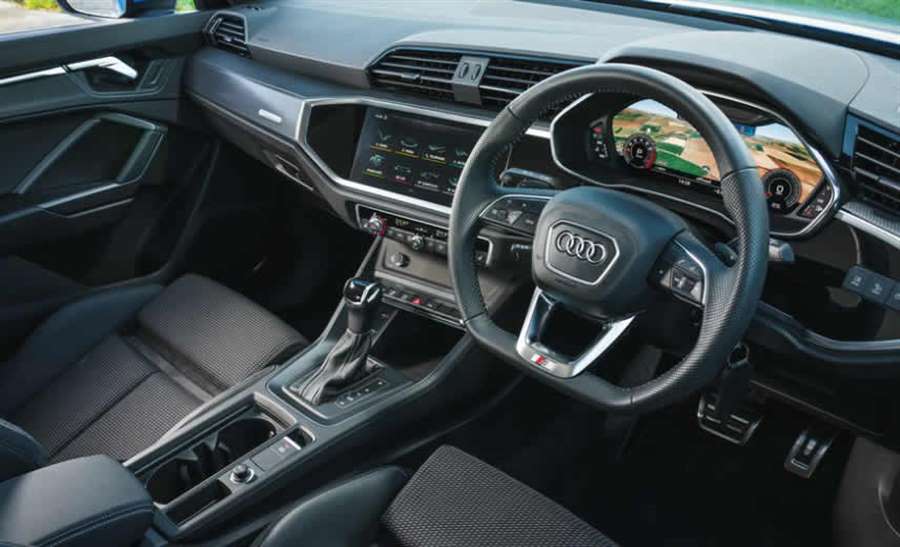
Impressively, even with the back seats in their most rearward position, there’s more space in the boot than you get in a BMW X1. With them set forward, the boot is really big and practical. Fold the back seats down and there’s easily enough room to carry a bicycle.
There are a few engines to choose from, starting with a 150hp petrol engine in the 35 TFSI model going right up to a 233hp petrol in the 45 TFSI, with 150hp and 190hp diesels in the mix as well. The entry point makes the most sense for most people as it’s better value for money.
A seven-speed automatic is available, but as it’s a bit slow to respond when you put your foot down, the manual model is absolutely fine. Some models have four-wheel drive (Audi calls it quattro) for extra grip, but it’s not necessary and adds to the cost.
Though the Audi Q3 is comfortable and composed, it’s more suited to motorways than country roads. It has a slightly stiff edge to the ride in versions with larger wheels and stiffer sports suspension, but at higher speeds, it’s smooth enough.
Light steering means it’s easy to drive, but it’s not particularly fun – a BMW X1 or Mini Countryman is a better choice for those who love driving. You get plenty of active safety kit as standard, but you’ll have to pay extra for adaptive cruise control.
The Audi Q3 is a great all-around family SUV, with strengths in the key areas buyers of these cars want. It’s spacious and has a great interior with loads of tech included, even if it’s on the expensive side. Still, you should be able to find a good deal by heading over to our deals page.
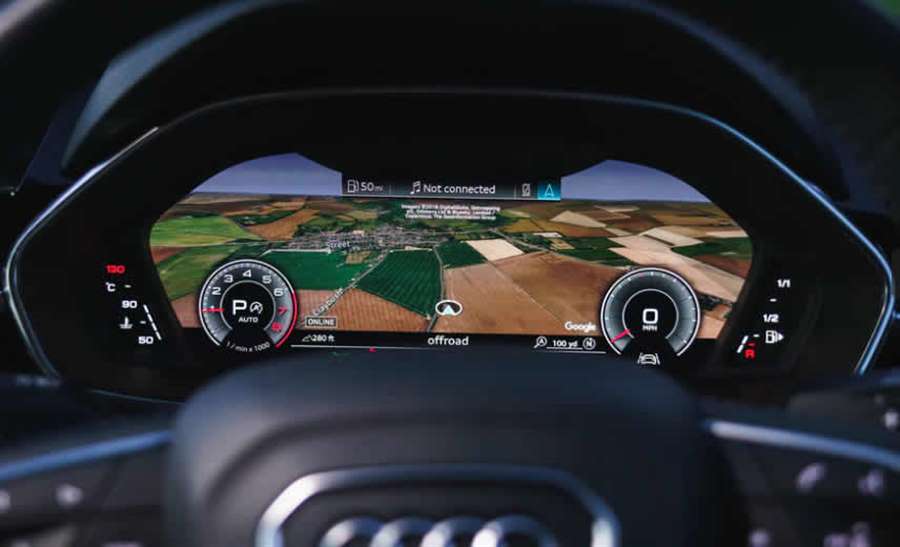
How practical is it?
The Audi Q3 might be a fairly compact SUV, but there’s loads of space inside for tall adults – the only real criticism is that there’s a large lump in the floor that cuts into a middle passenger’s foot space.
Audi Q3 interior
The Audi Q3’s interior looks far more futuristic than in most small SUVs. It gets lots of kit as standard, too, but the most eye-catching trims and colours are reserved for top-spec cars.
Style
The Audi Q3’s interior looks very similar to what you find in the range-topping Q8 SUV. There’s a large ring of metal-effect plastic on the dashboard that’s supposed to mimic the shape of the Audi Q3’s grille and a vast slab of glossy black plastic that sits flush with the central touchscreen.
You also get a second digital display in front the steering in place of conventional dials but, unlike in the Q8, the Q3 comes with intuitive physical knobs and dials for the climate control instead of a third (and rather fiddly) touchscreen.
As standard, the Audi Q3 comes with a fairly staid selection of black, grey and silver interior trims – all of which feel suitably soft and sturdy. Under the cool hook-shaped door handles you’ll find a few hard brittle surfaces, but these are tucked down far enough that you won’t notice unless you reach down to adjust your seat. On the subject of seats, pick a sporty S-Line model and you get upgraded front seats with more supportive padding and electric adjustment.
You can spruce up the Audi Q3’s interior with 30-colour mood lighting or upgrade the dashboard trims with some embossed aluminium or unvarnished wood. Go for a top-spec Edition One model and you can also get the dashboard, doors and seat edges trimmed in suede-like Alcantara in a range of colours.
Infotainment
Every Audi Q3 comes with a dual-screen infotainment system consisting of a 10.1-inch central touchscreen and a second 10.25-inch Virtual Cockpit digital instrument display as standard. Through these, you’ll access all of the Audi Q3’s onboard features – besides the climate control which is operated using a simple row of buttons by the gear lever.
The central display – which fits almost seamlessly into the Q3’s glossy black dashboard trim – is bright and easy to read, even in direct sunlight. It responds quickly to your inputs and all the menus are simply and logically laid out. You don’t get a physical scroll wheel like in a BMW X1, however, so flicking through settings while you’re driving isn’t quite so easy.
That being said, you can access plenty of the system’s features through the digital driver’s display instead, using handy buttons on the steering wheel. These let you customise the dial graphics, change the radio station or view upcoming sat-nav directions.
It’s easy to input an address into the Audi Q3’s standard navigation system using the on-screen keyboard and it gives clear and concise directions. The 3D google maps feature is a nice touch, too – allowing you to see whether there’s a particularly nasty hill approaching over the horizon. But, it can be difficult to read place names on particularly dark sections of the map.
It’s even easier to follow directions if you upgrade the standard 10.25-inch digital driver’s display to a 12.3-inch Virtual Cockpit system. This allows you to minimise the digital dials in favour of a huge widescreen map instead.
Unlike in the BMW X1, Apple CarPlay and Android Auto come as standard so you can use your phone’s navigation apps through the Q3’s built-in screens if you aren’t a fan of Audi’s own system. These features also let you play music from your phone through the Audi Q3’s stereo without resorting to using a Bluetooth connection.
You’ll want to upgrade to the optional Bang & Olufsen stereo – even if you’re only a casual listener. This optional 15-speaker unit sounds absolutely fantastic and it’s easily loud enough to drown out any comments your passengers might have about your music tastes.
Source: carwow.co.uk
Volvo XC90 hybrid Recharge T8 (2020) review: posh power
► 400bhp, 100mpg, 0-62 in 5.8seconds
► Swedish seven seater
► Frugal and fast - but not at the same time
Back when Elon Musk was merely known for crashing his McLaren F1 and Jeff Bezos was a bookseller, Volvos were safe and sturdy cars made for ferrying around your offspring.
Fast forward to today and the brand has evolved into a stylish desirable car marque that no longer just trades off being the safest around.
Keep hitting the fast forward button and you'll see that a new Volvo XC90 is due in 2021. It'll be a hybrid and EV only affair.
With this in mind - is the XC90 worth buying still? Or should people wait for the new car?
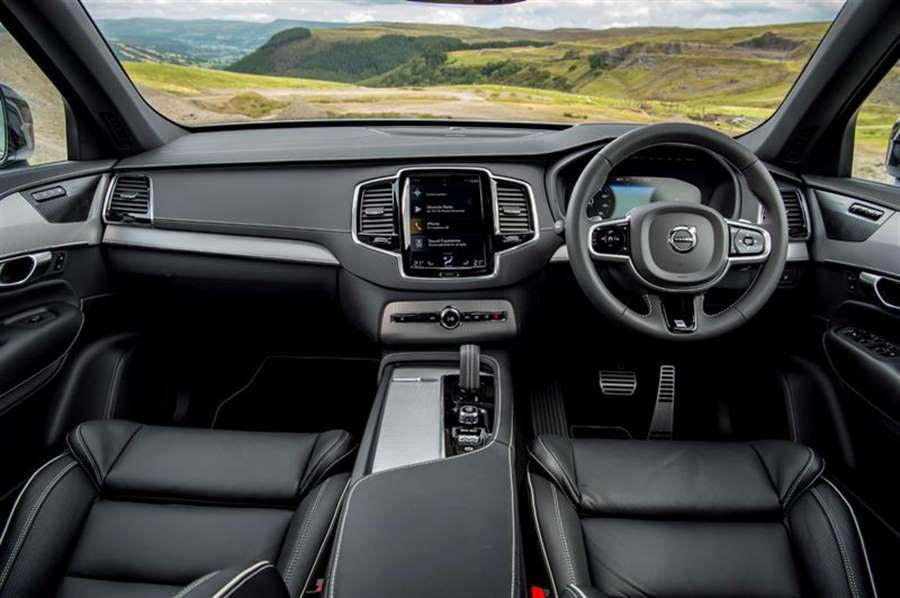
The best hybrid SUVs - on CAR
The XC90 T8 hybrid, or Recharge for short, is the most expensive, cleanest, frugalist, and quickest car of the XC90 range. Its raison d'etre is that it's a seven-seat plug-in hybrid - something of a rarity still.
It's aimed at the middle classes who can't quite commit to a fully-electric car, but still want the tax breaks and street cred associated with one.
While there's also a hint of the Q-car about it. Lovers of stealthy performance cars will be salivating at the thought of a 2.3-tonne family-hauler cracking the 0-62mph sprint in less than six seconds.
A 400bhp, £60k Volvo hybrid with a crystal gear selector
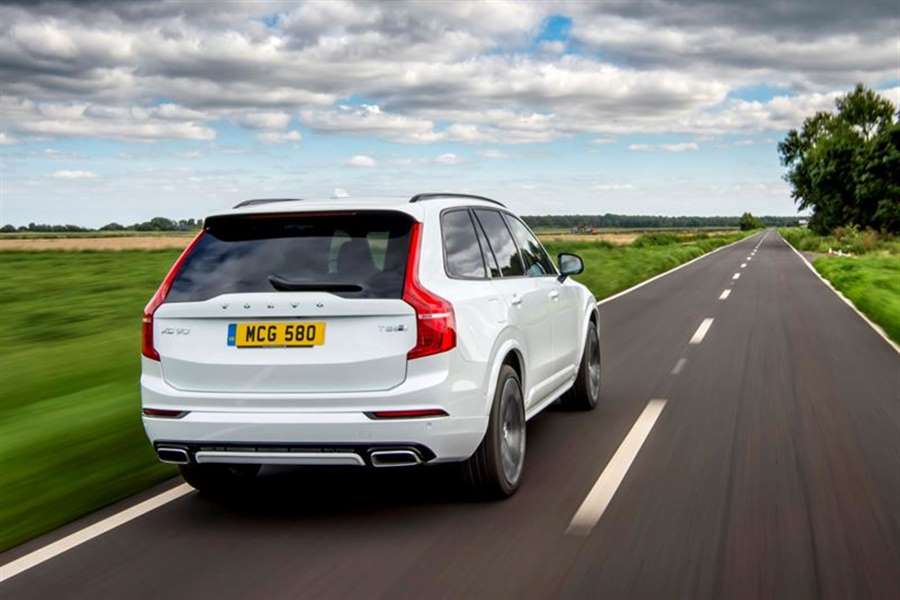
Expensive, fast, stylish and beautifully crafted, it’s a standard-bearer for the Swedish marque in its assault on the premium establishment, a move that’s being met with more success than Volvo dared hope.
The XC90 uses Volvo’s SPA scalable product architecture. It also underpins the S90 saloon and V90 estate, while the chassis was designed from the outset to package electric powertrains. In the T8 a petrol engine in the nose drives the front wheels via an eight-speed auto gearbox. A generator sandwiched between the two rapidly cranks the petrol engine into life, boosts torque and charges the battery as required.
The cells, housed in the central tunnel a propshaft normally calls home, feed a large single electric motor on the rear axle that also generates electricity under braking. A control unit in the engine bay synchronises the two power sources, ensuring happy, efficient collaboration and all-wheel drive when required.
Does the XC90 Recharge feel 400bhp fast?
Not quite – think effortless performance rather than unlikely dragster. Mash the throttle to the carpet in Power mode and the T8 launches pretty smartly, the battery pouring power into the electric motor as the turbocharged and supercharged direct-injection 2.0-litre four slogs its guts out. As a performance powertrain it’s undoubtedly effective, the claimed 5.8sec 0-62mph feeling entirely believable, but the car’s not inconsequential weight (2343kg) blunts performance.
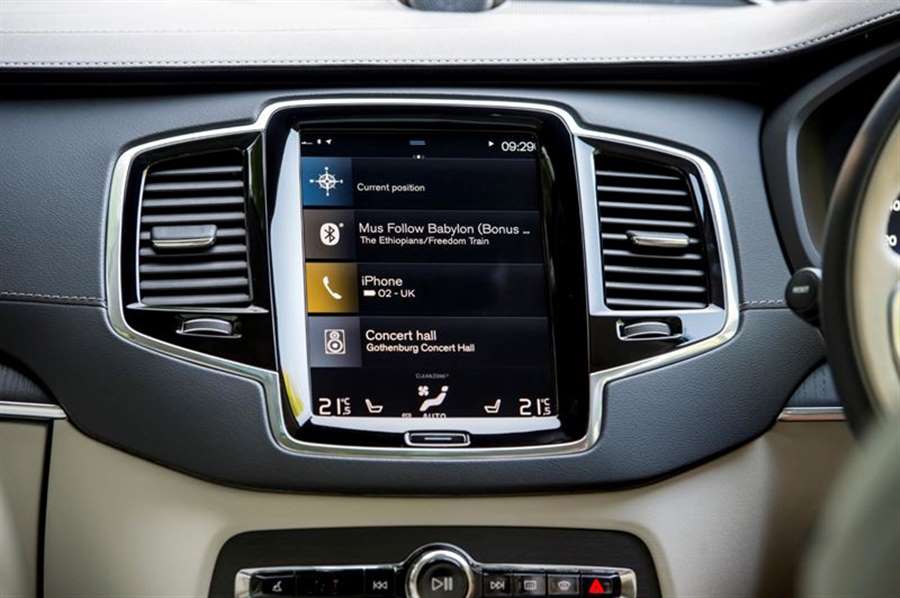
This kind of heavy-footed tomfoolery also feels pretty inappropriate, not because the chassis can’t cope – far from it – but because the petrol engine’s strains lack charm, shattering the XC90’s otherwise very endearing serenity. Volvo insists a more sonorous higher cylinder count would have been incompatible both with the firm’s product architecture and the wants of environmentally responsible consumers. Certainly the four-cylinder engine contributes much to the T8’s headline figures of 63-76g/km of CO2 and 83.1-100.9mpg on the combined cycle, though, after running one for six months, we can safely say the latter is an almost impossible figure.
The obscene three-figure MPG rating is synonymous with the plug-in hybrid car. We reckon if you charged religiously, and never drove more than 100 or so miles, the figure might be someway achievable. But the real hindrance to the XC90 is that when the battery is bereft of charge, you're realistically looking at a sub 30mpg car.
Volvo quotes an official electric range of 31 miles, but with day-to-day mixed driving expect more like 20.
Back to the drive modes. It's better to select the Hybrid and trade a little of Power’s throttle response and poke for improved economy and some far more agreeable peace and quiet. Either way the integration of electric and petrol power is almost seamless. At smaller throttle openings the petrol engine chiming in and out is almost undetectable, and the brake pedal is similarly well resolved, passing through the regenerative phase and into hydraulic braking with no discernible shift in resistance.
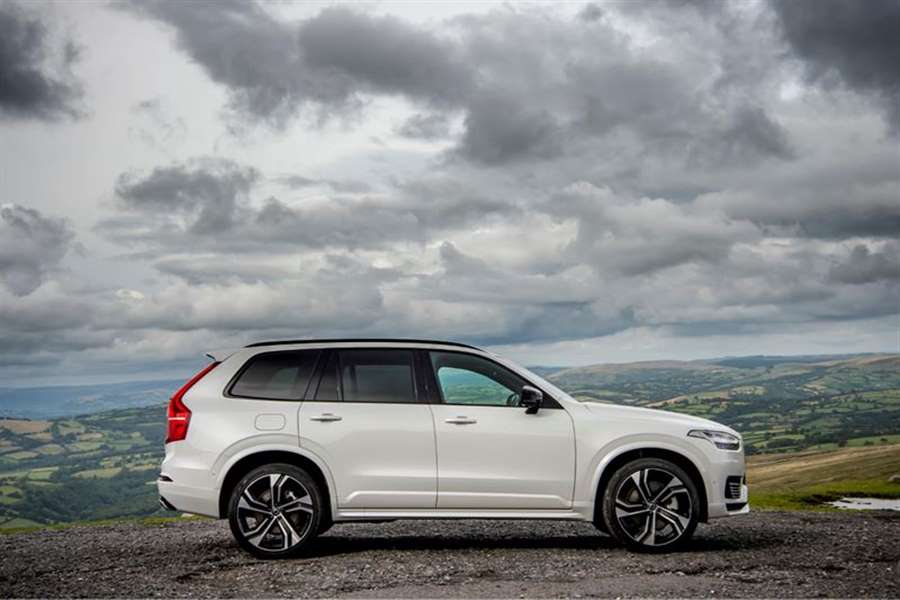
The usual PHEV functionality ensures a good degree of control: choose Pure mode to use only electric, select Braking on the gear selector for stronger regenerative braking on downhill runs, or even a lower gear for increased engine braking; use the instrument display or the dead-spot in the throttle pedal’s travel to stay on electric power, rather than accidentally triggering the petrol engine’s assistance.
High-rise limo or lively steer?
Air-suspended XC90s deliver an impressive drive, blending a cosseting ride with impressive body control. Appropriately there’s a little initial roll before the outer air struts take up the slack, lending the 5m-long seven-seater the wieldy feel of something much smaller and lighter.
Conventionally sprung XC90s manage a good impression of the same body control but lose a good deal of the ride quality, occasionally running out of answers on the kind of weather-beaten roads the UK does so well. So budget for the air suspension, which also drops the rear of the car by 50mm on demand for the easy loading of heavy furniture and arthritic dogs.
Back to that crystal gear selector
Curious timbers, machined aluminium and acres of beige leather don’t sound too promising but, almost irrespective of colour choice, the XC90’s is one of the finest interiors out there, certainly in anything like a comparable price bracket.
Fit and finish are exemplary, the design striking in a very pleasing, understated way and the overall sense of light, space and uncluttered calm the perfect ally to the T8’s potential for 31 miles of near-silent pure electric transportation. Additional NVH work has banished much of the background chatter of fans and compressors a combustion engine’s machinations normally mask, leaving an impressive and luxurious absence of noise.
Although the heating/cooling functions are controlled via the car's touchscreen. Which is annoying and fiddly on the move. Turning the heated seats on to their full power requires three stabs at the screen, for instance. And we can't help but the crystal gear selector is a bit...much.
Verdict
The XC90 is fundamentally a very fine SUV, and the hybrid powertrain has much to recommend it, not least the tax breaks afforded by its miserly CO2 output. While obviously 400bhp means it shifts like a V8.
However, for most people a diesel-engined XC90 delivers comparable if not superior economy, particularly if the battery’s never charged from the grid (50% of its existing PHEV owners don’t, according to Volvo) but the T8’s potential for both lunging bouts of acceleration and silent electric running is hugely attractive. Much like the car itself.
Since being launched, other manufacturers have caught up by offering plug-in hybrid SUVs. Audi, Range Rover, and BMW all have these in their arsenal - and all are newer too. Yet, the XC90 still delivers in being devastatingly fast and handsome, and nowhere near as audacious and flashy as them.
Source: carmagazine.co.uk
2020 Toyota C-HR Review: Fun Over Function
The verdict: The 2020 Toyota C-HR uses its funky styling (mostly) to its advantage, with a generous helping of standard safety features.
Versus the competition: The class of faux SUVs — lifted hatchbacks with SUV-like styling and cargo space that don’t even offer all-wheel drive — is growing, but the C-HR still stands out among the crowd thanks to its driving experience and safety features, not just its styling.
Though we usually let the images represent what a vehicle looks like, it’s hard to talk about the C-HR without at least acknowledging its styling. I called it ugly before it even went on sale, but I’ve actually mellowed in the years since. The sharp angles may not be for everyone, but at least it isn’t a generic blob or a traditional-looking SUV. The C-HR’s funky looks may even make it more appealing — at least to buyers looking to stand out in a sea of blah vehicles.
The 2020 C-HR has revised front styling, including new headlamps, but you’d be hard-pressed to discern what’s different without putting the two side by side. There are also new wheel designs to choose from.
Besides that, this is still the small, lifted hatchback that Toyota — and Cars.com, perhaps grudgingly — calls an SUV, despite its being exclusively front-wheel drive. It competes with similar FWD-only tall cars like the Hyundai Venue, Kia Soul and Nissan Kicks (see them compared).
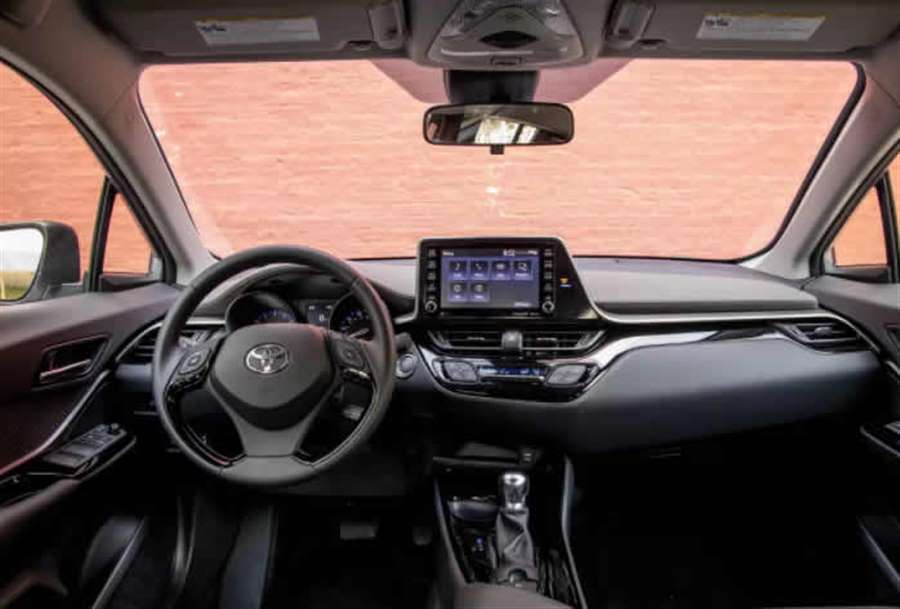
Interior and Cargo
The C-HR’s interior, particularly in the Limited trim I tested, has some hits and misses — not unexpected in a car costing less than $30,000. There’s decent leather upholstery on the Limited, and most of the hard surfaces don’t feel overly cheap, if not very upscale. Like on the exterior, there are fun aesthetic touches inside, such as textured plastic inserts in the door panels and oval designs scooped out of the headliner. Neither adds function or feels high-end, but they do add a touch of whimsy that I appreciate.
Another hit is the 8-inch touchscreen, which is flanked by physical buttons that control various functions, as well as volume and tuning knobs. The system operates quickly and the graphics are clear, if a bit dated. Apple CarPlay and Android Auto — the latter new for 2020 — are standard. Below the screen and central air vents are the climate controls, which are simple and easy to use.
Not so easy to use were the menus in the gauge cluster, which could display a variety of information (including the G-forces the C-HR was experiencing while driving) but not a digital tire pressure readout. Toyota buried the C-HR’s drive modes in there, too, making it a pain to switch modes. I accidentally stumbled across the modes the first time I drove the C-HR, but the next time I got in, I had to pull over and read the owner’s manual to figure out how to change them. Just give me a physical button or switch, please.
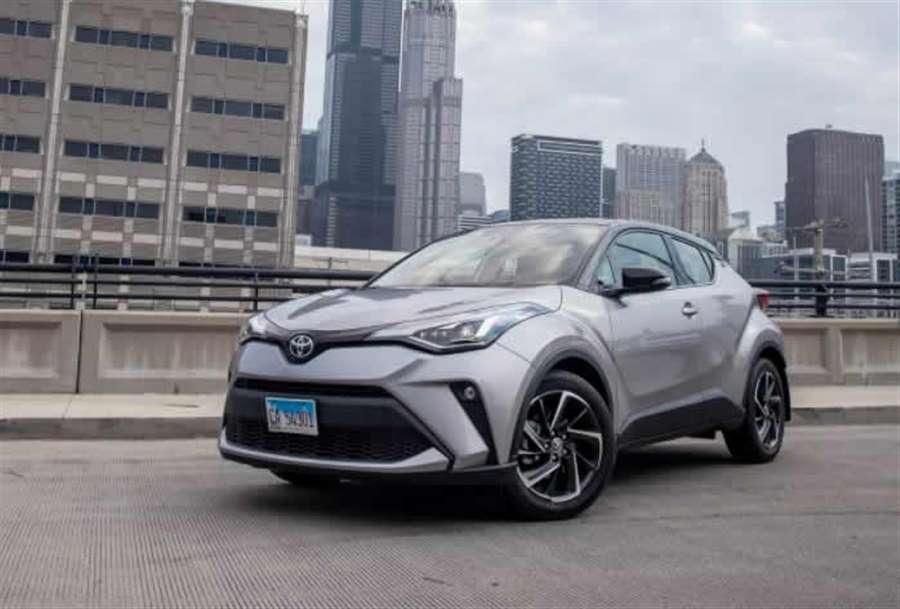
Another miss is in the rear. Surprisingly, I had ample legroom and a decent amount of headroom in spite of the C-HR’s compact size and sloping roofline, but its high beltline and tiny rear window contributed to a very enclosed feeling overall. It reminded me of sitting in the window seat on a plane when the window doesn’t line up with the row of seats and you have an obscured view the whole flight. ([Seinfeld voice] What’s the deal with that?) It’s not ideal, and it’s a direct consequence of the C-HR’s styling.
As for the cargo area, with the backseat upright, Toyota estimates the space at 19.1 cubic feet. In practice, it was enough for a pretty significant grocery run and would probably suffice for two adults’ luggage for a weeklong trip (though some stacking may be involved). With the backseat folded, the C-HR takes advantage of its extra length better than the rest of the faux SUV class — it’s more than a foot longer than the Venue, half a foot longer than the Soul and a few inches longer than the Kicks — to offset its low roof and increase cargo volume to 37 cubic feet (again, according to Toyota; we’ve found manufacturers to be inconsistent with such measurements).
What’s It Like to Drive the C-HR?
The “C” in C-HR stands for “coupe,” so you’d be right to expect a sporty — or at least sportier — driving experience. (“HR” is for “High Rider,” because it sits a little higher.) And there is some of that sportiness there, with direct, communicative steering and nimble handling that make the C-HR feel like it can be pushed harder than the Venue or Kicks.
The 144-horsepower, 2.0-liter four-cylinder engine also makes more horsepower than the Venue or Kicks, but it needs to; the CH-R outweighs those models by a substantial 743 and 609 pounds, respectively (comparing base trim levels). The Toyota has a continuously variable automatic transmission that leads to a great deal of droning noise at higher speeds or under aggressive acceleration. It also does a poor job of mimicking a traditional automatic transmission, leading to a noticeable rubber-band feeling when you hit the gas. That makes highway driving a bit of a chore, with a noticeable wait for passing power and added engine noise.
The 2020 C-HR’s gas mileage is at the bottom of this subclass, rated by the EPA at 27/31/29 mpg city/highway/combined with its standard four-cylinder engine. That’s a lower combined rating than the Kicks, Venue or Soul with its standard four-cylinder engine. If you get the 201-hp, 1.6-liter turbo four in the Soul, the combined ratings are the same, but the Soul Turbo is rated at 32 mpg on the highway.
The sportiness also makes for a firm-feeling ride — not uncommon for a small car, but the 18-inch wheels on my test car likely didn’t help. The LE gets 17-inch wheels, while the mid-range XLE also rides on 18s. Despite the harsher ride, the C-HR remained composed over broken pavement and expansion joints.
Visibility is another casualty of the C-HR’s styling, with the raked windshield putting the A-pillars in the way of traffic and pedestrians approaching from the sides, and the small rear windows and door windows make it more difficult to see what’s around you.
Safety
Fortunately, Toyota includes a full complement of standard safety tech on all C-HRs as part of its Safety Sense suite, helping mitigate its limited visibility. Those features include forward collision warning with automatic emergency braking and pedestrian detection, lane departure warning with lane keeping assist, adaptive cruise control, and automatic high beams. Adaptive cruise control is a nice touch for the class, particularly as a standard feature. Only the Soul Turbo offers it as an option; it’s not available on the Kicks or Venue.
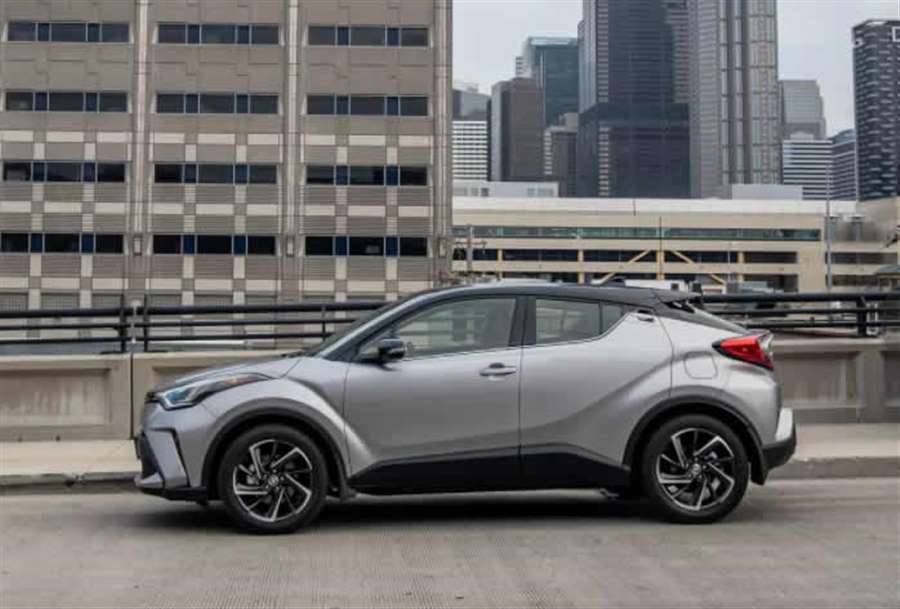
A welcome change since the C-HR’s debut? A backup camera image that appears on the infotainment screen instead of in the rearview mirror. It debuted in the 2019 model.
The C-HR aced the Insurance Institute for Highway Safety’s crashworthiness tests and its vehicle-to-vehicle front crash-avoidance tests. The LED headlights that come standard on the Limited also earned the highest possible rating of good, but the set that comes on the LE and XLE rated poor, IIHS’ lowest rating. (For perspective, mixed ratings — and poor ones — are common for headlights in the institute’s Small SUV class.) The National Highway Traffic Safety Administration gave the C-HR a five-star overall rating, with five stars for front and side impacts and four for rollover resistance.
Our last Car Seat Check, in which the C-HR earned mixed scores, was on a 2018 model. Results should apply to the 2020 C-HR, as well.
Within its class of FWD-only SUVs, the C-HR is one of the most expensive choices, particularly in the Limited trim — our test vehicle approached $30,000. Top trims of the Venue and Kicks, meanwhile, have sub-$25,000 prices, and the Soul Turbo offers more performance for a similar price. While the C-HR is more expensive, though, it does have more standard safety features and one of the more engaging driving experiences.
Expand the choices into small SUVs that do offer all-wheel drive and things get even murkier: The 2021 Kia Seltos, which just won our affordable small SUV comparison, costs only a few hundred dollars more than the C-HR Limited and brings AWD and a more traditional SUV silhouette. More expensive choices include the Mazda CX-30, which is much more enjoyable to drive and has a premium interior but a much less user-friendly infotainment system. The Subaru Crosstrek has a similar lineup of standard safety features and standard AWD, but it can cost more, particularly if you want the new optional 2.5-liter four-cylinder.
What may make the C-HR most appealing in an increasingly crowded field of both front- and all-wheel-drive small SUVs is its combination of unique exterior styling, safety features and sub-$30,000 pricing, particularly if shoppers are considering choices with all-wheel drive.
Source: cars.com
New Nissan X-Terra SUV introduced
The Japanese company talks about this model as "completely new", which should mean that it is something really new, but the truth is a little different. It is a seriously modernized SUV prepared for the 2018 model year, which is called the Nissan Terra. The frame-mounted SUV was developed on the basis of the Nissan Navara pickup truck, which competes in the market with such rivals as the Mitsubishi Pajero Sport or Toyota Fortuner.
The Nissan Terra SUV is sold in China, Thailand, Indonesia and other Asian countries. That is why the new Nissan X-Terra is intended for the countries of the Middle East, and for that reason Terra had to be "withdrawn from the game" in order to be polished in a way to satisfy more demanding customers from these specific markets.
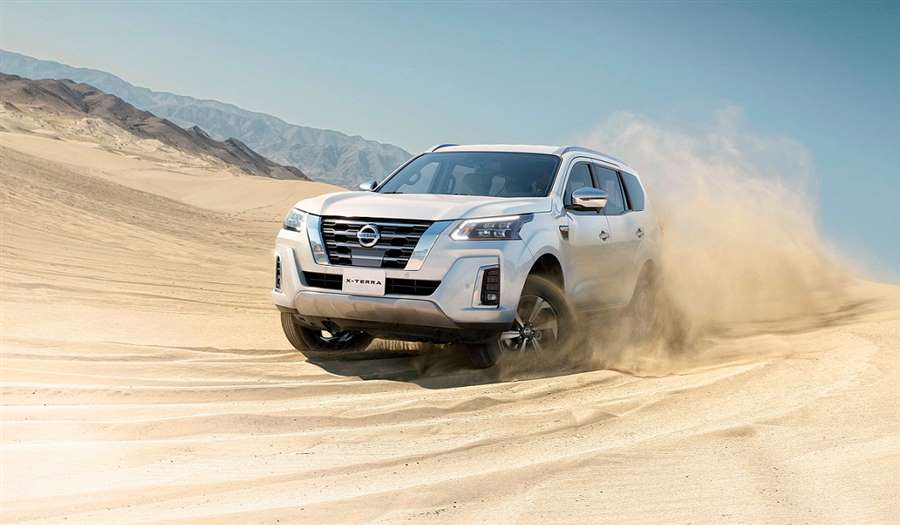
By the way, the constructor reached for the name of the newcomer in the company's archives, albeit with a slight change. The SUV of the same construction configuration was already on the production lines of the company under the name Nissan Xterra, in the period from 1999 to 2015.
The first generation of that vehicle was almost a global model (North and South America, China, Central Asia, the Middle East), but the second generation model is known only to drivers cruising on North American roads.
So, the Nissan X-Terra shown here differs from the original with the Terra sticker in a more seriously modified body style. The muzzle is styled in line with what we saw on the recently updated Patrol model, while the rear end is adorned with various heel doors and lighting in LED technology.
The rims are adorned with a diameter of 17 or 18 inches, while the ground clearance is really enviable and amounts to as much as 243 millimeters. As a result, the restyled 4,900-millimeter-long SUV looks significantly more solid than the donor model.
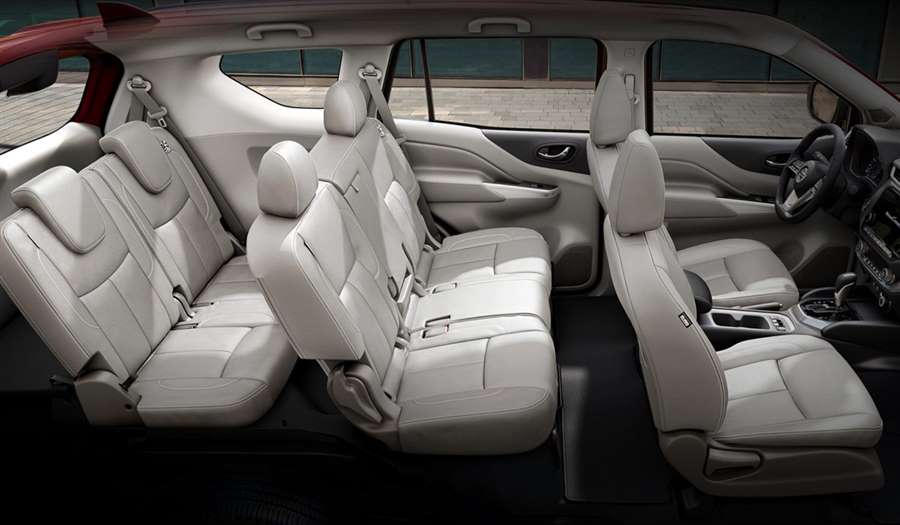
That is why the interior is completely new. If the Terra had an identical front panel as seen on the Nissan Navari pickup, then the X-Terra offers a completely original interior. It is made in the style of modern crossovers of the Japanese brand.
The instrument cluster, with a seven-inch screen, is placed in the middle of that mini panel, while on the central ridge there is another screen of the multimedia system, which can be eight or nine inches diagonally, depending on the configuration.
There is still the third row of seats. The most positioned variant offers an autonomous braking system in critical situations, monitoring of events in the area close to the vehicle, but which is in the driver's blind spot, assistance in maintaining the direction within the traffic lane, as well as some other electronic aids. On top of all the above, it should be said that the sound insulation has also been improved.
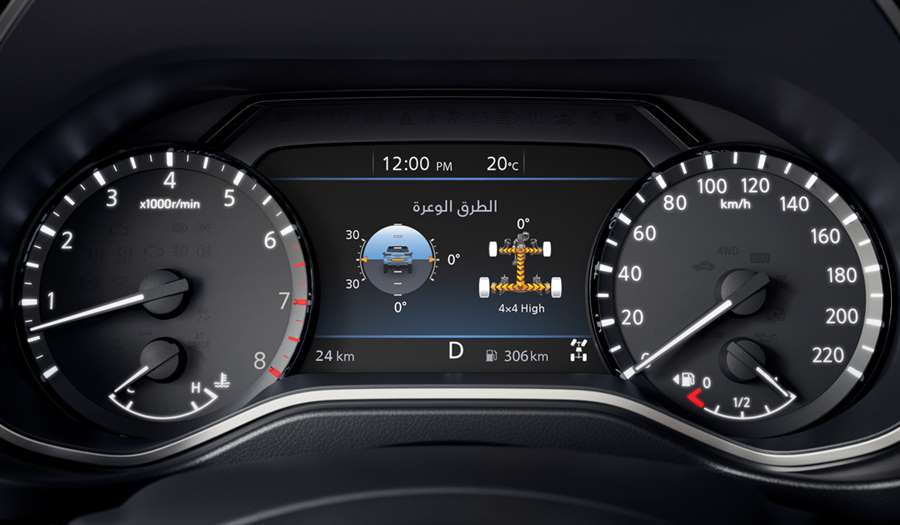
When it comes to the powertrain and chassis, it is necessary to say that these components are identical on the Terra and X-Terra models. The chassis is with double springs at the front and a continuous shaft at the rear end along the coil springs. The drive is on all four wheels with a tight connection and locking of the rear differential. There is also a reducer. There is also an electronic imitation of the lock.
However, the base version of the X-Terra has rear-wheel drive. Since we know that diesels are not at a price in the Middle East, the manufacturer has prepared a petrol, atmospheric 2.5-liter engine for the Nissan X-Terra SUV, which delivers 165 horsepower with 241 Nm of maximum torque. The engine is paired with a seven-speed automatic transmission.
Sales of the new model will begin in December while the starting price will be at the level of 27,200 US dollars. To add that, in Nissan’s global range, Terra and X-Terra will co-exist, and will not overlap in the same market. For example, the Nissan Terra for the 2020 model year was presented in Thailand a few days ago.
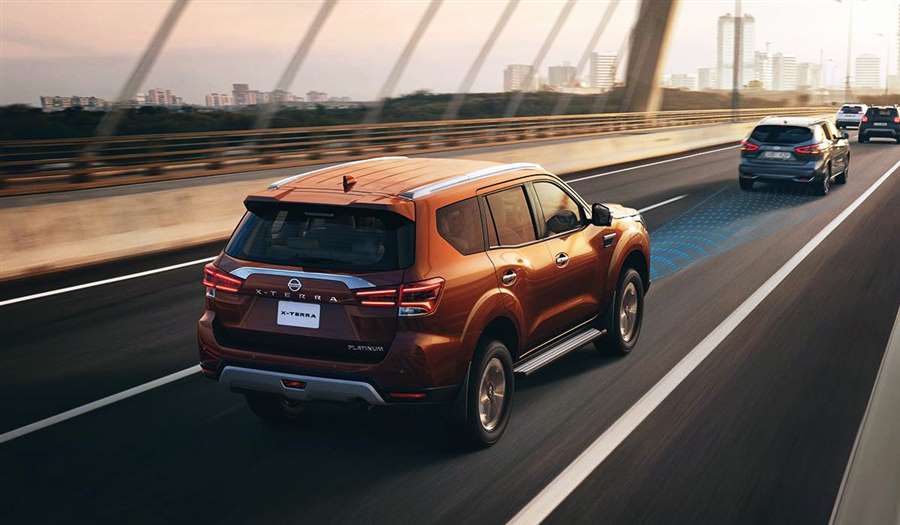
Either way, it’s possible that in a year or two, the Asian Terra will become just as advanced as the X-Terra is today. However, we do not believe that any of these models will reach Serbia, nor the surrounding countries.
Skoda Karoq Review
If you want a well-built small SUV with plenty of space, the Skoda Karoq is well worth a look. Just don’t expect to be wowed by its design or the way it goes around corners.
The Skoda Karoq is the Czech brand doing what it does best – providing practical family transport with plenty of equipment and few fripperies. It’s comfortable, too, but you’ll have to look elsewhere if you want style and driving entertainment.
In short, it’s the knife and fork of the SUV world, dead simple and wonderfully effective.
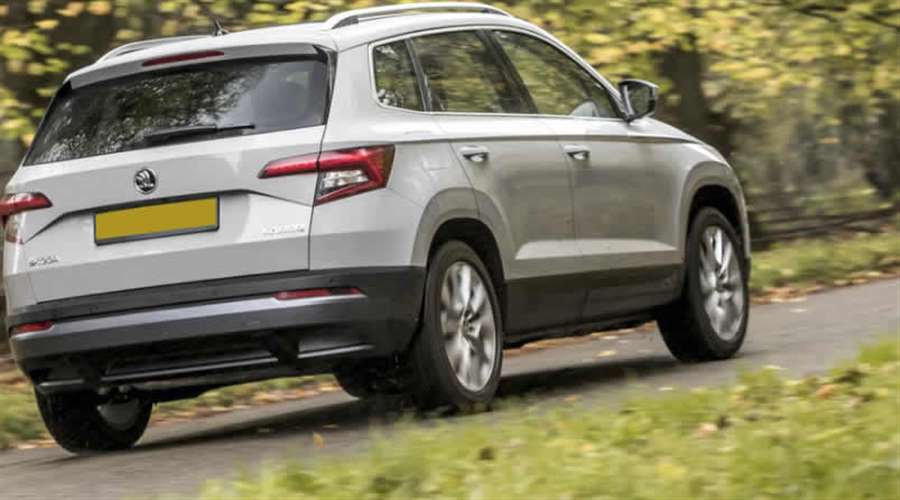
Having said all that, the Skoda Karoq is an excellent choice if you want a roomy small SUV with a raised driving position and a solid-feeling interior. As an added bonus, it comes with loads of clever features that’ll make it dead easy to live with.
The Skoda Karoq isn’t a car to shout about all its clever kit, though – it certainly doesn’t look as flashy as the sportier Hyundai Tucson and Kia Sportage. You do get some cool two-piece headlights like on the larger Kodiaq and the Karoq’s raised ride height means it’ll still tower over most conventional family hatchbacks in the school car park.
Step inside, and the Skoda’s sensible, staid theme continues – garish colours and oddly placed buttons just aren’t Skoda’s style. While this might mean the Karoq’s cabin isn’t particularly memorable, it does mean everything’s a doddle to navigate and use – including the standard 8-inch touchscreen infotainment system.
You’ll be sitting comfortably while you fiddle with the Skoda’s built-in gizmos, too. Every model comes with height-adjustable front seats to help you get settled and there’s absolutely loads of space for tall adults to stretch out.
The Skoda Karoq’s sliding rear seats and wide cabin mean three adults won’t feel like tinned sardines in the back and the boot’s roomy enough to carry everything you need for a family week away. It’s easy to load and you can even remove the back seats in high-spec cars to carry some seriously bulky loads, just like in a van.
The Skoda Karoq is a no-frills family SUV with a very practical cabin and a range of sensible, economical engines.
Mat Watson, carwow expert
That said, the Skoda Karoq drives much better than any van ever will. Entry-level SE models have comfy suspension that only jars over sharp bumps and the cabin is quiet at a cruise – save for a little bit of wind noise coming from the door mirrors.
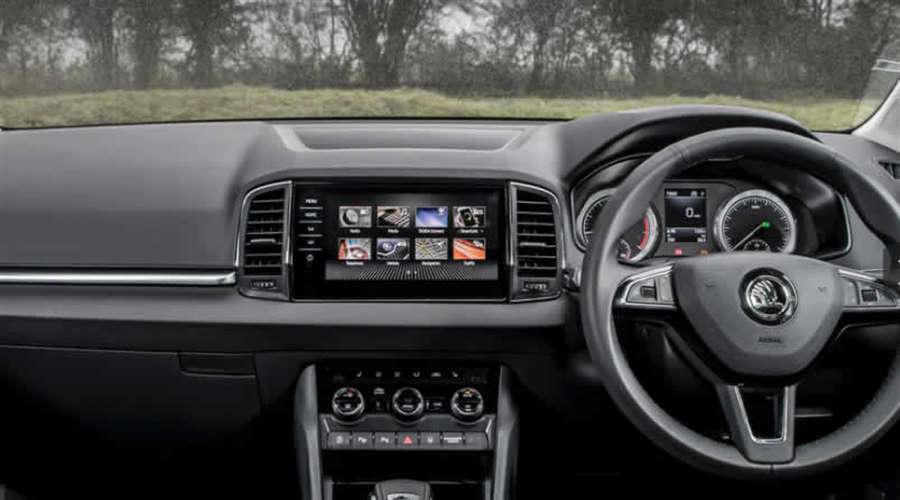
You won’t notice any of this around town, but the slightly jerky automatic gearbox can start to frustrate when pulling out of junctions and parking in town.
Stick to the standard six-speed manual and one of the Skoda Karoq’s smaller petrol engines though, and it feels right at home nipping to the shops or pottering along urban streets.
If motorway journeys are more your thing, a diesel will be more economical and you’ll want to consider the optional adaptive cruise control that’ll accelerate, brake and steer to keep you in lane.
All this makes the sensible Skoda Karoq one of the safest and most practical small family SUVs on sale. It’s well worth seeing how much you can save by checking out our Skoda Karoq deals, then.
Common Skoda Karoq questions
What does Karoq mean?
Kodiaq, Karoq, Kamiq… you see the theme here – Skoda names its SUVs starting with the letter K and ending with the letter Q.
The origins of the Karoq name goes deeper than that, however. The name is derived from Alutiiq – a native Alaskan language. Karoq is a combination of the terms ‘KAA’RAQ’ (car) and ‘RUQ’ (arrow – an arrow is part of the Skoda logo). Hence Karoq.
Is the Skoda Karoq 4-wheel drive
The Skoda Karoq can come with four-wheel drive. The 2.0-litre 190hp petrol and the 2.0-litre 150hp diesel are 4×4 cars. And remember, the chunkier Karoq Scout model is only available as a 4×4.
Where is the Skoda Karoq made?
The Skoda Karoq is made at Skoda’s main plant in Mlada Boleslav alongside the Octavia, Fabia, Scala and the new Kamiq SUV.
How practical is it?
The Skoda Karoq has a big boot and space inside for four tall adults. The VarioFlex back seats can slide and recline individually, or be removed for a huge load bay
Skoda Karoq interior
The Karoq’s cabin might not be particularly exciting to look at but it feels sturdy and all models get a slick 8-inch touchscreen infotainment system as standard
Style
The Skoda Karoq’s interior is logically laid out, solidly built and packed with useful features.
Expensive-feeling soft-touch plastics are used for the top half of the dashboard and the doors, and although the lower half of the dashboard’s plastics aren’t soft they don’t look cheap.
The large glovebox lid feels robust and opens with a damped action, you get flashes of chrome and reasonable looking trim pieces that brighten up the interior. The only black mark in terms of quality is the cheap-looking plastic used for the lower half of the doors.
Even entry-level cars get an 8-inch colour touchscreen with clear graphics which does wonders for adding a bit of a high-tech air to the Karoq’s cabin.
SE models have chrome door handles and chrome surrounds for the air vents that give them a classier look than an equivalent Nissan Qashqai. The Karoq comes with attractive dark cloth upholstery that should hide bad stains very well. SE L models are worth considering though because they come with suede-effect upholstery that looks and feels expensive.
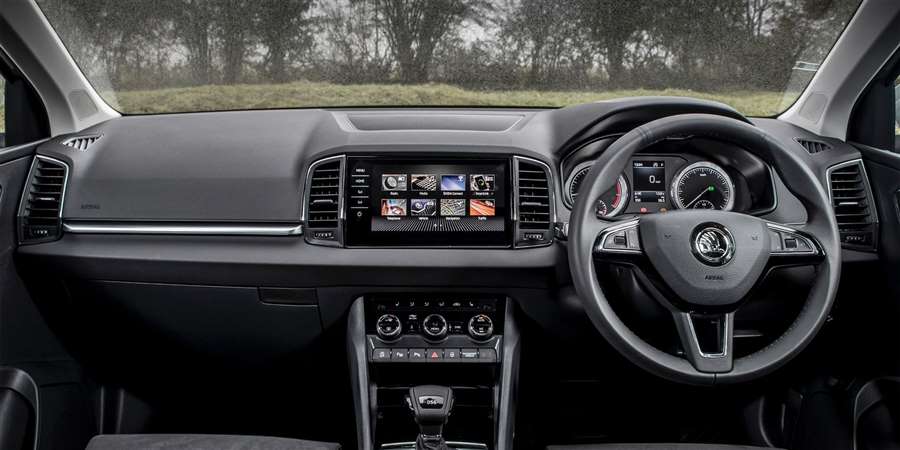
In fact, it’s nicer than the leather you get in Edition models, although the latter should be a lot easier to keep clean. Edition models also get lights that illuminate the sides of the car at night – so you don’t hop out into puddles – and ambient lighting that makes the interior look prettier at night.
If you fancy something a bit sportier, there’s also the aptly named Sportline model. These versions come with more supportive front seats with some contrasting silver trim, a set of aluminium pedals and a posher leather-trimmed steering wheel.
Infotainment
Even the entry-level SE Karoq comes with an 8-inch touchscreen that’s smart looking and easy to use.
It’s actually slightly easier to operate than the upgraded system because it has a couple of large knobs for volume and scrolling in and out of maps.
Sat-nav doesn’t come as standard, but you do get Android Auto, Apple CarPlay and Smartlink so you can use the navigation apps on your compatible smartphone via the Karoq’s big screen. It’s such a good system that you’ll not miss having integrated sat-nav and it also makes it easier to access your phone’s contact list and play music.
Mid-range SE L models’ infotainment screens look exactly the same but do come with Skoda’s own sat-nav system. Its graphics are slightly more detailed than the ones you get when you use your phone, but your phone’s sat-nav is better because it can route around congestion.
Edition models are the only ones to come with a 9.2-inch sat-nav screen that has a faster processor – although loading times are quick enough on the other systems – and a higher-resolution display.
Its touch controls – for volume and map scrolling – are trickier to operate when you’re trying to concentrate on driving, but on the plus side, they give the system a pretty, glassy appearance that looks a fair bit posher than the cheaper screens. It also gets gesture control – so you can wave your hand to scroll through menus, but its unresponsiveness means it isn’t worth the extra cash.
Source: carwow.co.uk
The first details about the all-new Nissan Qashqai
One of the first and best-selling mid-size SUV models in the world is Nissan's "Qashqai". The third generation of this crossover is now in preparation, which, according to the announcements, will bring many changes in design and advanced technologies. As expected, electrified versions will be offered for the first time.
As a pioneer in the medium crossover segment, the "Qashqai" has been sold in Europe since 2007, where over 3 million units have been produced to date.
By the time it was replaced by the second generation in 2014, 17 direct competitors followed the "Qashqai" in the market with their models.
Despite the arrival of many European competitors, the first generation is sold in over 200,000 units per year during its lifetime.
Now the current model has as many as 26 direct competitors, among which are: "Renault Kadjar", "Ford Kuga", "Hyundai Tucson", "Mazda CKS-5", "Skoda karoq" and many others.
That is why it is very important for the new generation to continue at a successful pace and that is why its approach is very serious.
The new Qashqaii is based on the all-new CMF-C (Renault-Nissan) platform. It has been announced that it will use technologies from higher categories of cars, as well as that the proportions will be maintained. In terms of construction, the body will be lightened by as much as 60 kg, but also 41% stronger.
For now, it is known that it will be offered with front-wheel drive and 4 × 4, as well as with a 1.3-liter gasoline engine with mild hybrid technology, and Nissan's innovative e-POVER system, which contains an electric drive, is mentioned.
In conventional hybrid wheel systems, it is powered by an electric motor and a petrol engine, however, in the e-POVER system, the petrol engine is not connected to the wheels - only on a full battery.
The new "Qashqai" will be equipped with the next generation of ProPILOT for driving assistance, and the premiere is expected in the spring of 2021.

